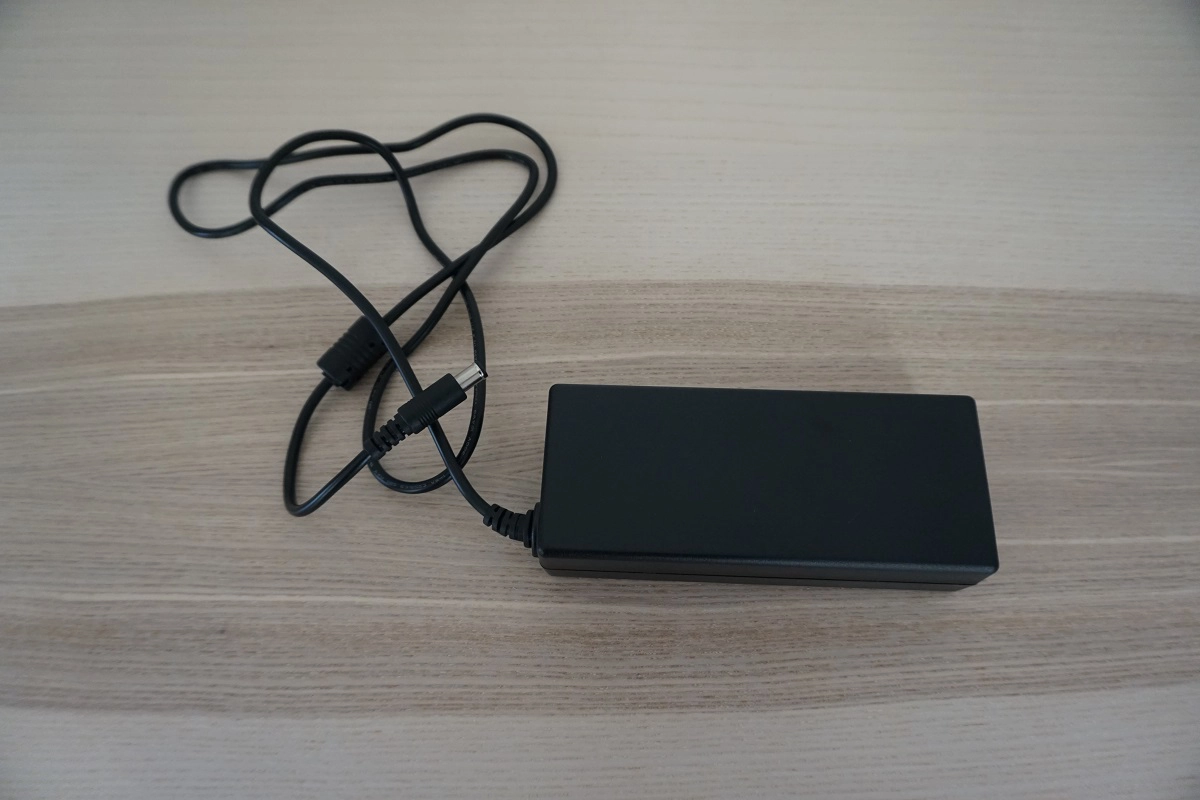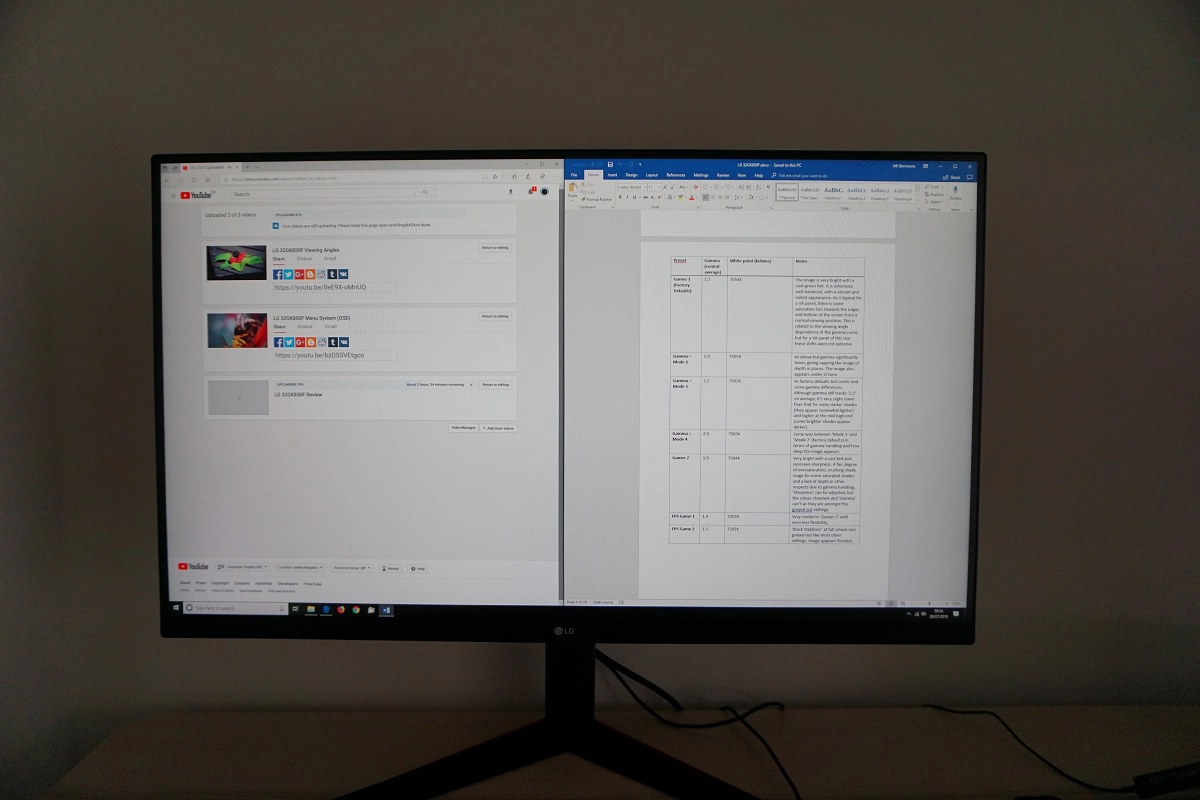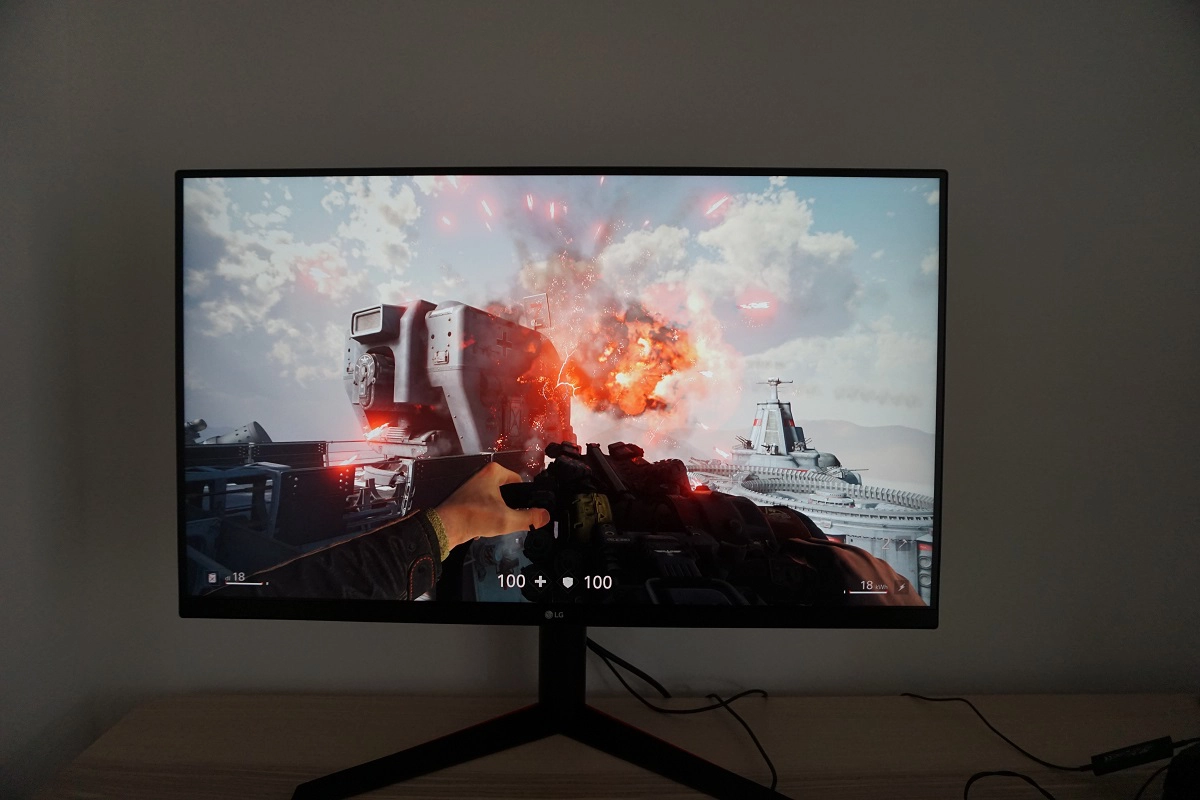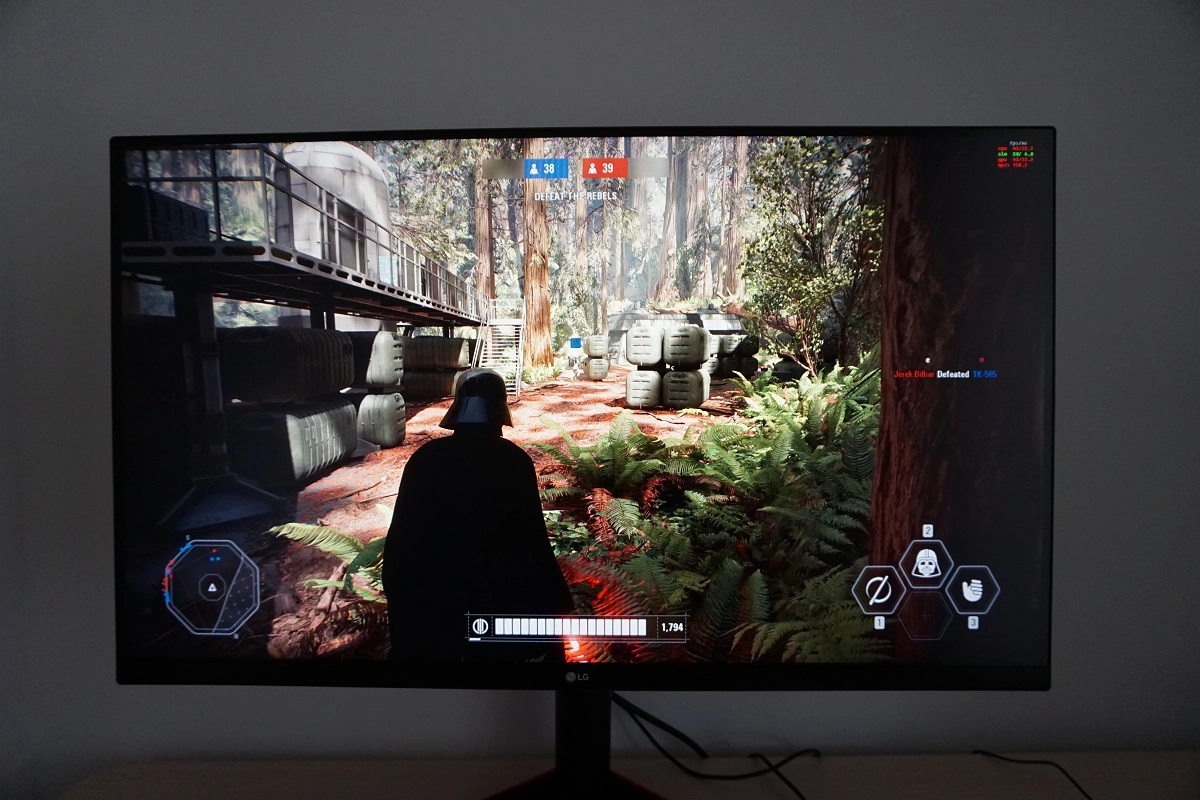Author: Adam Simmons
Date published: July 31st 2018
Table of Contents
Introduction
Amongst the high refresh rate VA monitors, the LG 32GK850G has proven itself to be one of the more capable monitors, mixing strong contrast and decent colour output with good responsiveness. The LG 32GK850F (32GK850F-B extended designation, owing to its black back) supports AMD FreeSync 2 rather than G-SYNC and, bringing a more generous colour gamut and support for HDR into the mix. So it has a lot to offer to Nvidia and AMD GPU users as well as console gamers who have systems capable of handling the native resolution. We put this monitor through its paces in our usual suite of ‘real-world’ tests, seeing how it stacks up against its G-SYNC counterpart and other competing models.
Specifications
The monitor uses a 31.5” AU Optronics AMVA (Advanced Multi-Domain Vertical Alignment) panel with support for a 144Hz refresh rate. True 8-bit colour is also supported, without dithering. A 5ms grey to grey response time is specified, with 1ms MPRT specified with the ‘Motion Blur Reduction’ strobe backlight feature active. These figures should, as usual, be taken with a dose of salt. Some of the key ‘talking points’ for this monitor have been highlighted in blue below, for your reading convenience.
The monitor looks fairly understated for a gaming monitor, without obvious dashes of colour or odd geometric features. Black matte plastic is used extensively, with a few red elements here and there – such as at the tear of the stand feet. The now popular dual-stage (‘3-side frameless’) design are used here, with a slender panel border around the image and a very thin hard outer component. The panel border blends in seamlessly when the monitor is switched off. Including both components, the bezel is ~9.5mm (0.37 inches) at the top and sides. The bottom bezel is thicker with only a sliver of panel border visible, ~24mm (0.94 inches) including both components. Most of your field of view when using the monitor is of course occupied by the 31.5” screen itself, which uses a light matte anti-glare screen surface as explored shortly. The OSD (On Screen Display) is controlled by a joystick on the underside of the bottom bezel, in the central region. The joystick has an integrated power LED, which can’t be seen from a normal viewing position and is off by default although can be enabled in the OSD. If enabled, it glows red when the monitor is on and flashes red when the monitor enters a low power state. The video below runs through the OSD. From the side the screen is reasonably slender, ~23.5mm (0.93 inches) at thinnest point and extending back further in the central region. The monitor is mainly matte black plastic from the side, with some red elements at the rear of the stand feet. There is a central stripe of glossy black plastic at the side of the screen, too. Because of how they’re angled and how low they are to the desk, the red highlights are nor prominent from a normal viewing position. You can also see the stand, with quite a robust design and good ergonomic flexibility; tilt (5° forwards, 20° backwards), swivel (20° left, 20° right), height adjustment (110mm or 4.33 inches) and pivot (90° clockwise rotation into portrait). At lowest stand height, the screen clears the desk surface by ~75mm (2.95 inches) with the top ~496mm (19.53 inches) above the desk. The total depth of the monitor and stand is 290mm (11.42 inches) with the screen quite close to the nearest points of the stand. As with the rest of the screen, the rear is mainly matte black plastic. There are some red elements as well, including a ring at the top of the stand neck, the rear of the stand base feet and most notably the ring around the central region. Unlike on the ‘G’ model, this red ring does not house any ambient lighting feature such as ‘Sphere Lighting’. The stand attaches using a quick-release bracket mounting mechanism. You can remove the included stand using the switch beneath the attachment point and attach an alternative 100 x 100mm VESA solution if preferred. There is a clip-on cable tidy that fits to the bottom of the stand base, should you wish to use it. The ports face backwards in a recessed region to the right of the stand attachment point and include; USB 3.0 upstream, 2 USB 3.0 ports (with fast charging), DP 1.2a, 2 HDMI 2.0 ports, 3.5mm headphone jack and a DC power input (external power brick, shown below). So this model has an extra HDMI port compared to the ‘G’ model and supports HDMI 2.0. The monitor will run at up to 144Hz at the native resolution via DP 1.2 and HDMI 2.0. Compatible GPUs also support AMD FreeSync (via Adaptive-Sync) via DP or HDMI, whilst HDR compatible GPUs and systems support HDR via DP or HDMI. This includes games consoles and Nvidia GPUs. Standard accessories include a DP cable, HDMI cable, USB 3.0 cable and a power cable and adaptor. The images below are macro photographs taken on Notepad with ClearType disabled. The letters ‘PCM’ are typed out to help highlight any potential text rendering issues related to unusual subpixel structure, whilst the white space more clearly shows the actual subpixel layout alongside a rough indication of screen surface. The top image shows the 32GK850F, whilst the bottom image shows the AOC AG251FG included for comparison. As explored later, this model uses a light matte anti-glare screen surface. This handles glare effectively whilst keeping the image free from obvious graininess and better preserving vibrancy than some matte surfaces. The 32GK850F features various ‘Game Mode’ presets; ‘Gamer 1’, ‘Gamer 2’, ‘FPS Game 1’, ‘FPS Game 2’, ‘RTS Game’, ‘Vivid’, ‘Reader’, ‘HDR Effect’ and ‘sRGB’. ‘Gamer 1’ is a fully customisable preset, whereas the remaining presets lock off various settings such as ‘Gamma’, ‘Color Temp’ and ‘Black Stabilizer’. The table below shows key readings taken using a DataColor Spyder5ELITE colorimeter alongside some general observations. It was connected to a Windows 10 machine in its ‘Plug and Play’ state without additional drivers or ICC profiles specifically loaded. We also tested with the latest monitor driver available to us, in case this had a positive effect on FreeSync range (it didn’t). We left the screen to run for over 2 hours before observations or readings were made.The system primarily used an Nvidia GTX 1080 Ti. We performed additional testing via HDMI and also with a Radeon Club3D Radeon R9 290 royalAce FreeSync-compatible GPU. Unless otherwise stated, assume that settings were left at default (including ‘Contrast’) with refresh rate set to 144Hz. The refresh rate setting didn’t affect our observations here or affect static image quality elsewhere in the review. When viewing the figures in this table, note that for most PC users ‘6500K’ for white point and ‘2.2’ for gamma are good targets to aim for.
As an Amazon Associate I earn from qualifying purchases made using the below link. Where possible, you’ll be redirected to your nearest store. Further information on supporting our work.
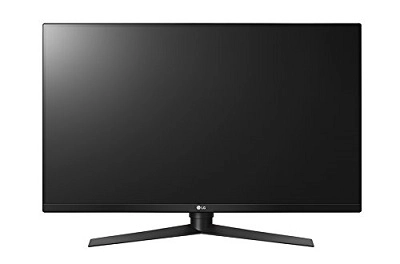
Features and aesthetics
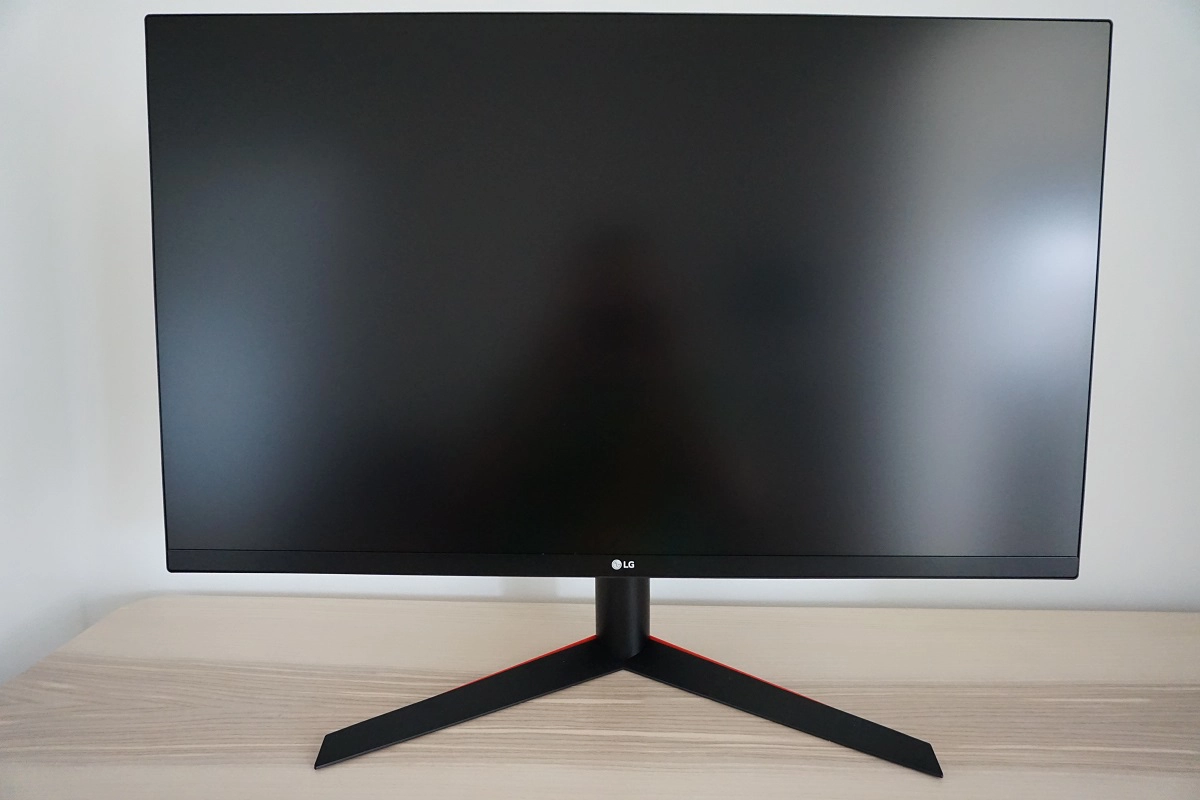
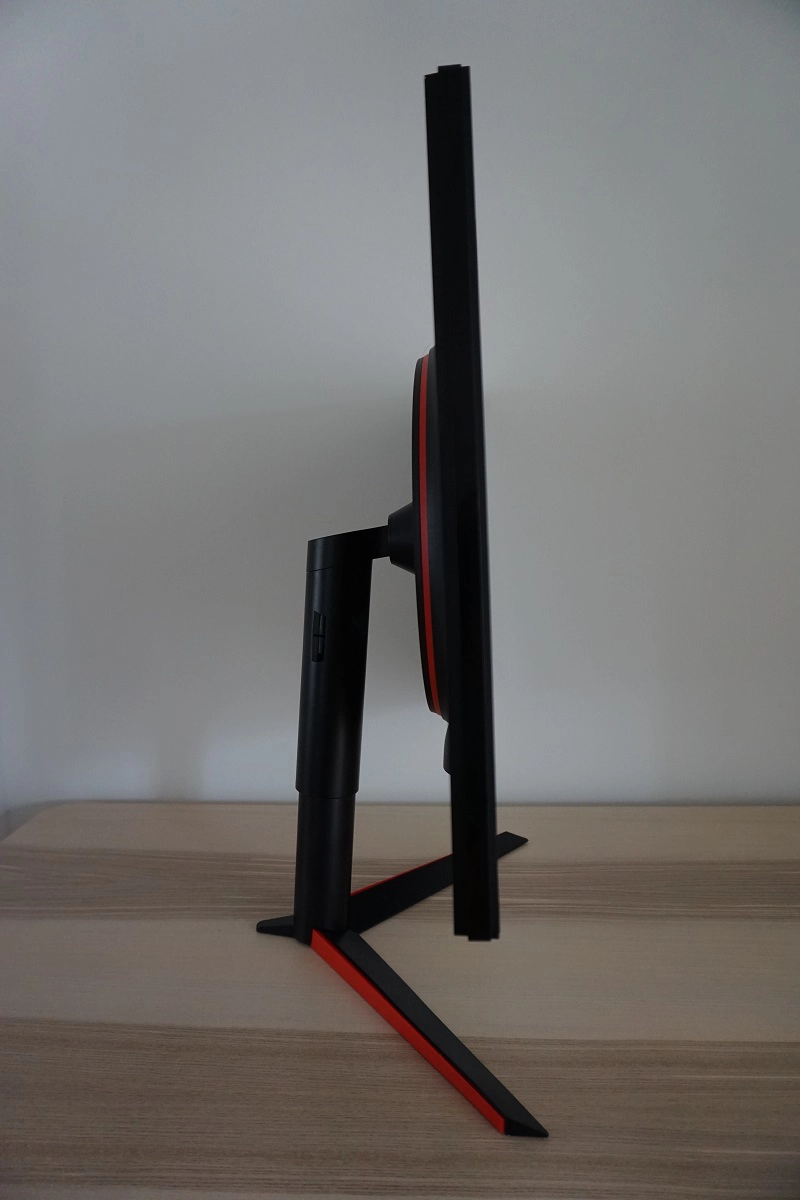
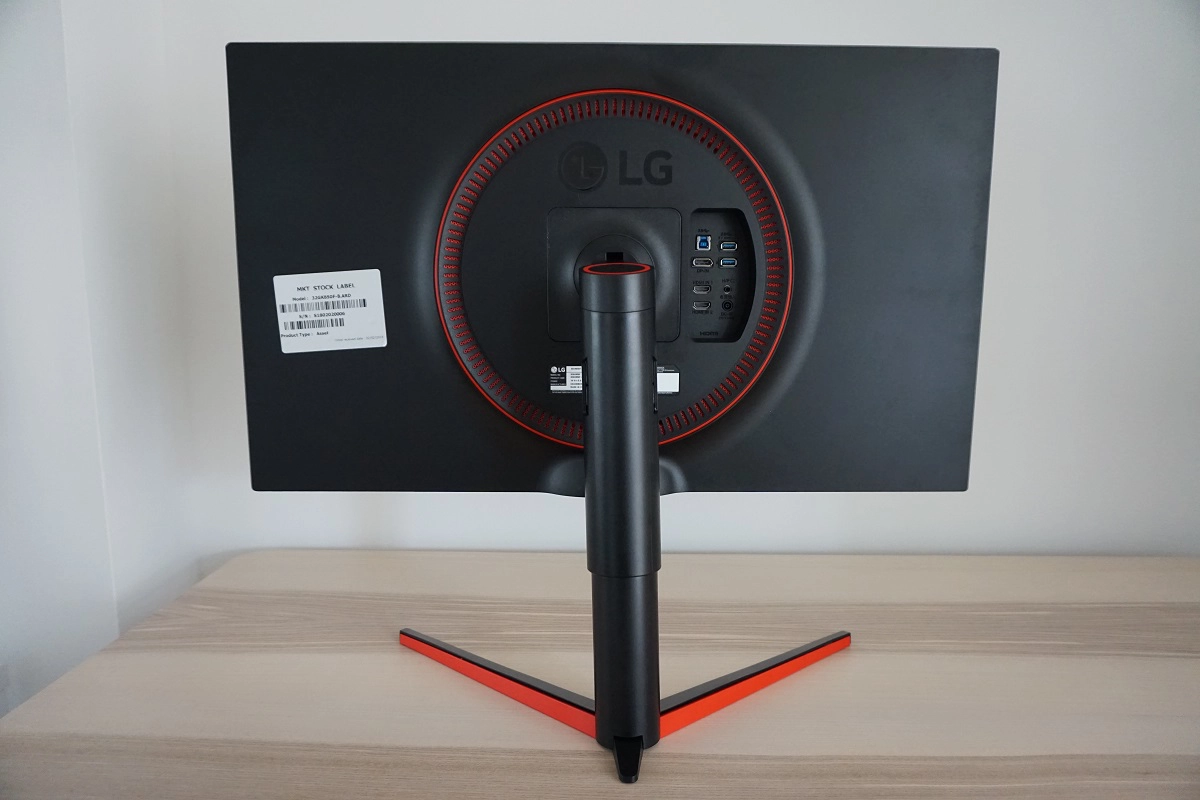
Calibration
Subpixel layout and screen surface
![]()
![]()
As shown above, the monitor uses the usual RGB (Red, Green and Blue) stripe subpixel layout. This is the typical layout expected by modern operating systems such as Microsoft Windows and Apple MacOS. You needn’t worry about text fringing from non-standard subpixel layouts as a Mac user and don’t need to run ClearType as a Windows user – although you may wish to run through the ClearType wizard and adjust according to preferences. You can see from the top image, taken from this monitor, that the subpixels are slightly squat with relatively ‘thick’ black spaces above and below each row. You can also see that some areas of text are shown with only half of each subpixel illuminated, with fairly distinct gaps in the middle and at the ends of letters where there is no subpixel illumination. Compare this to the bottom image, which shows a more blended appearance without the same half subpixel illumination or abrupt gaps. This subpixel arrangement is not uncommon on VA models and can cause issues with text clarity, particularly if (as in this case) the pixel density is not particularly high. It causes slight issues with text clarity, with text on this model appearing somewhat softer than it ideally would. It appears with a slight ‘shadowy’ fringe around it in places, with the fringe a lighter shade than the text itself. Running through the ClearType wizard and slightly increasing sharpness can help counteract this slightly, but it can’t completely overcome the softening. Most users will not take issue or even notice that text appears different to usual on this model vs. a model of similar pixel density and normal subpixel arrangement. Some users would notice and potentially find this bothersome, however.
Testing the presets
Monitor Settings Gamma (central average) White point (kelvins) Notes Gamer 1 (Factory Defaults) 2.2 7054K The image is very bright with a cool-green tint. It is otherwise well-balanced, with a vibrant and varied appearance. As is typical for a VA panel, there is some saturation loss towards the edges and bottom of the screen from a normal viewing position. This is related to the viewing angle dependency of the gamma curve, but for a VA panel of this size these shifts were not extreme. Gamma = Mode 1 1.9 7505K As above but gamma significantly lower, giving sapping the image of depth in places. The image also appears cooler in tone. Gamma = Mode 3 2.2 7502K As factory defaults but cooler and some gamma differences. Although gamma still tracks ‘2.2’ on average, it’s very slight lower than that for some darker shades (they appear somewhat lighter) and higher at the mid-high end (some brighter shades appear darker). Gamma = Mode 4 2.0 7503K Some way between ‘Mode 1’ and ‘Mode 2’ (factory defaults) in terms of gamma handling and how deep the image appears. Gamer 2 1.9 7204K Very bright with a cool tint and excessive sharpness. A fair degree of oversaturation, crushing shade range for more saturated shades and a lack of depth in other respects due to gamma handling. ‘Sharpness’ can be adjusted, but the colour channels and ’Gamma’ can’t as they are amongst the greyed out settings. FPS Game 1 1.9 7203K Very similar to ‘Gamer 2’ with even less flexibility. FPS Game 2 1.3 7202K ‘Black Stabilizer’ at full whack and greyed out like most other settings. Image appears flooded, but excellent (cheat-like) visibility in dark areas. RTS Game 1.6 7201K Some way between the two ‘FPS’ modes, with ‘Black Stabilizer’ set to a medium-high level. Vivid 2.2 7054K Extreme oversaturation and crushing of shades. Image appears exceptionally vivid, but unrealistically so and lacking range. Reader 1.8 4886K An effective ‘Low Blue Light’ (LBL) setting which also minimises contrast. The image appears warm and ‘flooded’. The blue light reduction is in line with the setting as implemented on the G-SYNC variant, but the decrease in contrast is unique here. Relaxing evening viewing (see below) 2.2 4419K Because we don’t appreciate the drop in contrast or find it beneficial ourselves, we made some manual adjustments to create a highly effective LBL setting without the same impact on contrast. The image appears very warm and the blue channel is minimised effectively, with significant blue light reduction. HDR Effect 2.2 7664K This is an HDR emulation mode, a preset that can be used in conjunction with SDR content only. We’ve never seen such a setting deliver anything more than an ugly image, and this is no exception. Overly cool and bright for most content, frequent brightness fluctuations, extreme oversaturation and lack of shade variety and excessive sharpness. sRGB 2.2 6920K A comfortable brightness (adjustable), but too cool in tone with locked many settings (including colour channels and gamma modes) locked off. Image quite well-balanced overall with good shade variety and a vivid appearance. This is not an ‘sRGB emulation’ mode as colour gamut is not altered. Test Settings (see below) 2.2 6495K As factory defaults with much more comfortable brightness, colour re-balancing and a few other minor tweaks. The image is vibrant with good depth and variety.
Out of the box the monitor provided a bright green and cool-tinted image. It appeared vibrant with good depth and shade variety, however. With a few minor tweaks (as per our ‘Test Settings’, below) it was possible to bring even better balance to the image. The graphic below shows the gamma tracking under our ‘Test Settings’, with little deviation from the desirable ‘2.2’ curve. Given the intended uses of the monitor, inter-unit variation and pleasing performance following OSD tweaking alone we will not be providing any ICC profiles for this model or using them in the review. The monitor also included an effective Low Blue Light (LBL) preset called ‘Reader’. This provided a significant reduction in both the blue channel and luminance compared to the factory defaults, making it suitable for comfortable evening viewing. It also had a significant effect on contrast, reducing this massively. In that respect it was different to the setting on the G-SYNC model and more similar to what Samsung has implemented with their ‘Eye Saver’ mode. The reduction in contrast is intentional as it is supposed to reduce the amount of time your eyes spend adjusting to changing light levels from the monitor. As the changes in light levels are far more subtle. We didn’t find this drop in contrast beneficial or necessary (some users may prefer it), so we made some manual tweaks for what we referred to as ‘Relaxing evening viewing’ in the table. This was for our own viewing comfort later in the evening rather than any specific testing of the monitor. They were identical to the ‘Test Settings’ (below) but with colour channels set to R= 50, G=30, B=0. These are just a suggestion and can be tweaked a bit according to preferences – it’s also quite inconvenient to have to adjust the channels back and forth between these and the ‘Test Settings’. LG could certainly improve things by offering a dedicated LBL setting that does not have a dramatic effect on contrast, or simply by offering more than one preset that allows you to manually adjust colour channels. For our ‘Test Settings’ we lowered brightness significantly and made some changes to the colour channels to present a more balanced image, without a cool-green tint. We also slightly increased the sharpness as we subjectively preferred ‘60’ over the default of ‘50’ – it certainly didn’t entirely offset the somewhat softer look of text due to the subpixel arrangement and related processing, but we did feel it slightly improved things. Setting this higher introduced some pronounced green and red fringing around some text and the highest settings gave a generally over-sharpened look, which was unattractive to us. Note that individual unit and preferences vary, so these settings should only be used as a guide and not considered optimal for all users. Assume any setting not mentioned, including ‘Contrast’ and ‘Gamma’, was left at default. We also disabled the ‘SMART ENERGY SAVING’ feature as this can cause brightness fluctuations according to the content being displayed on some LG models. With this one it only seemed to have an effect (albeit limited) if the DFC (Digital Fine Contrast) Dynamic Contrast feature was active, but we disabled it to be safe. We’ve included the ‘Response Time’ setting and refresh rate used for reference, too. We had to make a small GPU driver tweak on our GPU when the monitor was connected via DP and FreeSync was enabled. There is a small colour processing issue by default which means things look noticeably undersaturated. You simply need to open ‘Radeon Settings’, navigate to ‘Display’ – ‘Color’ (little icon towards the top right) and press the ‘Color Temperature’ toggle so it reads ‘6500K’ instead of ‘Automatic’. Brightness= 33 (according to preferences and lighting) Sharpness= 60 (according to preferences) R= 50 G= 42 B= 43 FreeSync= Extended Response Time= Fastest SMART ENERGY SAVING= Off Refresh rate (Windows setting)= 144Hz When first opening HDCP protected content, for example accessing Netflix via a browser or the app, the monitor sometimes suffered HDCP handshake issues with our Nvidia GPU. At times the screen lost signal for around 20 – 40 seconds or sometimes indefinitely whilst it performed what appeared to be a delayed HDCP handshake. Rather than waiting for the screen to sort itself out, it was often quicker to simply turn it off then on again. This would usually instantly establish the handshake, although sometimes this too failed and the only recourse was to Alt+F4 the application and repeat the process. We only observed this via DP, not HDMI, and once this handshake was performed you could run the content itself without interruption. Including watching anything else on Netflix. Once you open up the application or browser again, though, the HDCP handshake needs to be re-established and the process may well repeat itself. We only observed this issue our Nvidia GTX 1080 Ti, not our AMD Radeon 290. Our review sample was a very early revision of this monitor (December 2017) so it is something that may be ironed out in later revisions. Installing the latest available monitor driver did not affect this or indeed any other aspect of the monitor’s performance. Otherwise, if you frequently access such content you may wish to use simply use HDMI instead – assuming your GPU supports HDMI 2.0 for the full functionality of the monitor. A BasICColor SQUID 3 (X-Rite i1Display Pro) was used to measure the luminance of white and black using a range of monitor settings, including those analysed in the calibration section. From these values, static contrast ratios were calculated. Results are shown in the table below. Blue highlights indicate the results under our ‘Test Settings’ and with HDR active, whilst black highlights indicate the highest white luminance, lowest black luminance and highest contrast ratio recorded. Assume any setting not mentioned was left at default, with the exceptions already noted in the calibration section.
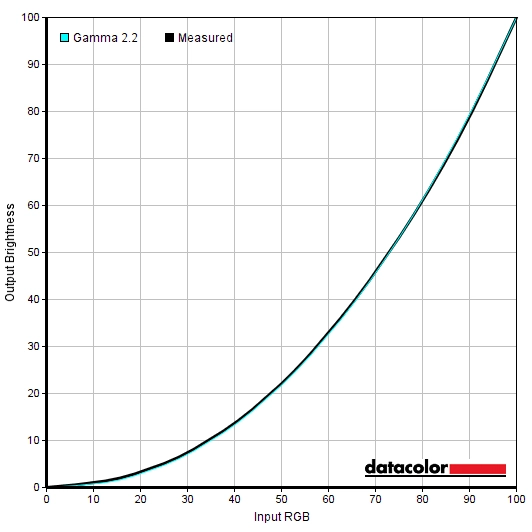
Gamma 'Test Settings'
Test Settings
Game Mode= Gamer 1
HDCP handshake issue (Nvidia DP only)
Contrast and brightness
Contrast ratios
Monitor Settings White luminance (cd/m²) Black luminance (cd/m²) Contrast ratio (x:1) 100% brightness (Factory Defaults) 424 0.16 2650 80% brightness 357 0.13 2746 60% brightness 289 0.11 2627 40% brightness 218 0.08 2725 20% brightness 145 0.05 2900 0% brightness 72 <0.03 >2400 HDR* (100% brightness) 198 0.18 1100 HDR* (50% brightness) 120 0.1 1200 HDR* (0% brightness) 34 <0.03 >1133 Gamma = Mode 1 446 0.16 2788 Gamma = Mode 3 445 0.16 2781 Gamma = Mode 4 445 0.16 2781 Gamer 2 404 0.44 918 FPS Game 1 404 0.46 878 FPS Game 2 404 0.46 878 RTS Game 403 0.46 876 Vivid 387 0.15 2580 Reader 98 1.44 68 Relaxing evening viewing 144 0.07 2057 HDR Effect 447 0.18 2483 sRGB 182 0.07 2600 Test Settings 175 0.07 2500
*HDR measurements were made using this YouTube HDR brightness test video, running full screen at ‘1440p HDR’ on Google Chrome. The maximum reading from the smallest patch size (measurement area) that comfortably covered the entire sensor area and colorimeter housing was used for the white luminance measurement, which was ‘4% of all pixels’ in this case. The black luminance was taken at the same point of the video with the colorimeter offset to the side of the white test patch, equidistant between the test patch and edge of the monitor bezel.
The average static contrast with only brightness adjusted was 2730:1, with a maximum recorded value of 2900:1. This is very close to the specified 3000:1 and provides good depth to dark shades, with brighter shades standing out nicely against darker surroundings. The contrast isn’t as high as some VA models, which sometimes have contrast closer to 5000:1, so there isn’t the same inky depth. It’s still far better in this respect than what any SDR non-VA LCD can provide. Following the adjustments made to our ‘Test Settings’, contrast remained pleasing at 2500:1. Many of the presets dropped the contrast down significantly, sometimes to below 1000:1. This is because many of the presets activate the ‘Black Stabilizer’ setting – setting this at all above ‘50’, which is the neutral point, significantly decreases the black point. The lowest contrast recorded was a mere 68:1 using the ‘Reader’ preset. This purposefully minimises contrast as explored in the calibration section – our custom Low Blue Light (LBL) setting (‘Relaxing evening viewing’) provided effective blue light reduction whilst keeping contrast above 2000:1. The highest luminance recorded in this table was a rather bright 447 cd/m², whilst the lowest white luminance (under SDR) was 72 cd/m². This is reasonably dim although not as sim as some users with sensitive eyes might like. This yielded a brightness adjustment range of 375 cd/m².
When running in HDR, the monitor put in a disappointing contrast performance. We weren’t expecting miracles given that the monitor is only VESA DisplayHDR 400 certified (we explore this later), but even then we’d expect contrast to at least be as good as under SDR. The monitor provides no local dimming capabilities and had to compromise with its brightness in the test we ran. Whether set to ‘0%’, ‘50%’ or ‘100%’ brightness, the contrast ratio barely exceeded 1000:1. The black point always seemed higher than it should be for a given white luminance output level. We fiddled with every conceivable setting in the OSD (and graphics driver), tried various refresh rates and tested both HDMI 2.0 and DP 1.2. The luminance and contrast did not ever improve in this test. Although not specifically documented in the table, we also tested with a full white screen fill on the HDR test. This brought the maximum luminance closer to the maximum recorded outside of HDR. However; with no local dimming capability, the black depth was severely lacking at such high luminance. Obviously, we couldn’t measure this under the white screen fill condition, but our in-game observations made later on certainly support this.
The monitor also provides a Dynamic Contrast setting called ‘DFC’ (‘Dynamic Fine Contrast’). This allows the backlight to adjust its brightness based on the content on the screen under SDR. These adjustments happen anyway under HDR regardless of this setting being active or not, so it’s curious that it isn’t greyed out to avoid confusion under HDR. As usual the backlight is controlled as a single unit rather than any local dimming being supported. The backlight responded to luminance changes with moderate pace, although the luminance adjustment range seemed focused around quite a limited range. You can manually adjust brightness and the monitor seems to dim or brighten a bit around this value depending on the content displayed. The ‘Smart Energy Saving’ setting should in theory change how this operates, with ‘High’ providing a bias more towards dimmer backlight levels than ‘Low’ or ‘Off’. In practice this setting didn’t seem to make an obvious difference. We liked the flexibility that you get from this gentle Dynamic Contrast implementation, it was preferable to the obnoxiously bright implementations or those which constantly adjust rapidly all the time. But we still prefer keeping this setting disabled and having manual control over the brightness, we don’t really feel it offers any real advantage over normal manual backlight control.
PWM (Pulse Width Modulation)
The monitor uses DC (Direct Current) to dim the backlight and does not use PWM (Pulse Width Modulation) at any brightness setting. The backlight is therefore considered ‘flicker-free’, which will be welcomed by users who are sensitive to flickering or worried about the side-effects of PWM usage.
Luminance uniformity
Whilst observing a black screen in a dark room we observed no obvious backlight bleed or clouding. There was very minor clouding towards the bottom left. The image below shows this, taken in a dark room using our ‘Test Settings’ as well as camera settings which are representative of what the eye sees when observing the screen. Note that individual units vary when it comes to uniformity issues such as backlight bleed and clouding, although VA models like this tend to be relatively strong in this respect. The image was taken a sufficient distance back from the screen to eliminate so-called ‘VA glow’, which is a silver-purple glow that appears from a normal viewing position towards the bottom of the monitor, particularly near the corners. It blooms out more noticeably ‘off-angle’ as demonstrated in the viewing angles video later. As explored shortly, it’s only a minor issue on this model. It’s more subtle than on some VA models and it is nowhere near as obtrusive as ‘IPS glow’. The luminance uniformity was pleasing. The maximum luminance was recorded at ‘quadrant 6’ to the right of centre (150.3 cd/m²). The greatest deviation from this occurred at ‘quadrant 7’ towards the bottom right of the screen (136.6 cd/m², which is 9% dimmer). The average deviation between each quadrant and the brightest recorded point was 5.5%, which is very good. Note that individual units vary when it comes to uniformity and you can expect further deviation beyond the points measured. The contour map below gives a graphical representation of these deviations, with darker greys representing lower luminance (greater deviation from brightest point) than lighter greys. The percentage deviation between each quadrant and the brightest point recorded is also given. We also measured colour temperature (white point) uniformity for these same white quadrants. Deviations here are shown in the contour map below and are assigned DeltaE values. A higher value indicates greater deviation from the 6500K (D65) daylight white point target than lower values. Here, a DeltaE <3 is considered non-significant deviation that most users wouldn’t readily notice by eye. Note that greater deviations are shown using stronger (deeper) yellow shades. Results here are good, with no significant deviations recorded. The highest deviation recorded was DeltaE 2.6 towards the top right. As above, individual units vary when it comes to uniformity and you can expect deviation beyond the measured points. It’s also important to remember that VA models such as this have perceived shifts in colour temperature and to a lesser extent brightness due to viewing angle weaknesses. These aren’t accounted for by such readings. In addition to the quantitative testing above, we performed a subjective assessment of the uniformity of a variety of ‘medium’ shades, including 50% grey. Some monitors exhibit uniformity issues such as splotches or striations when viewing screen fills of such shades, giving an inconsistent appearance that some users refer to as ‘DSE’ (‘Dirty Screen Effect’). VA models are particularly prone to this, but we did not observe such issues with our 32GK850F sample. On Battlefield 1 (BF1) the monitor provided a strong contrast performance. Dark shades appeared quite deep with brighter elements standing out nicely against darker surroundings. This not only helped give darker scenes in the game a nice atmospheric look, it also gave shadow detailing a more distinct appearance, giving good 3D structure to objects. There was a small amount of ‘black crush’, which describes dark shades (excluding black) appearing even darker than intended from a normal viewing position. They blend into one another, so some subtle details aren’t as distinct as they should be. You can see this when observing the central screen area whilst sitting directly in front of the screen – viewing these shades from an angle or observing them near the edges of the screen will reveal these subtle details and, in some cases, extra (unintended) detail. This was as minor as we’ve seen on a VA model, so a good level of detail remained intact compared to models like the AOC Q3279VWF. There was also a bit of ‘VA glow’, slightly lightening up dark shades towards the bottom corners of the screen in particular. This was far more minor than the detail losses associated with ‘IPS glow’ and was less obtrusive than even typical ‘VA glow’ on competing curved models such as the AOC AG322QCX. Finally, even the lightest shades appeared quite smooth without obtrusive graininess from the screen surface – a positive attribute of the light matte anti-glare surface employed here. We made similar observations on Dirt Rally, where darker elements appeared quite deep and atmospheric with lighter elements standing out nicely against them. The night time scenes on this game are particularly dark, so it’s good to see a nice atmosphere maintained when driving at night on this game – something most LCDs fail to deliver. There was not an obtrusive level of ‘glow’ to speak of and static contrast was quite strong. Brighter shades such as car headlights and the bright moon in the sky appeared quite smooth without obvious graininess. Some minor details such as car tire tread patterns were masked slightly by ‘black crush’ but were still visible along with most other minor details. We also assessed contrast on the Blu-ray of Star Wars: The Force Awakens. This movie had a lot of high contrast scenes where dark and light clashed, quite appropriately in this case. Bright light sabers and explosions stood out nicely against the deep depths of space, or indeed the curiously dark rooms that often feature on this film. The contrast wasn’t as stark as you’d see on some VA models with even stronger contrast or indeed a glossy screen surface, but surpassed what other LCD panel types produce for SDR content. Lagom’s contrast tests were used analyse specific strengths and weaknesses in contrast performance. The following observations were made. The colour gamut of the 32GK850F (red triangle) is compared with the sRGB (green triangle) and Adobe RGB (purple triangle) colour spaces in the image below. The monitor comprehensively covers the sRGB colour space (100% reported) with significant extension beyond this. There is also comfortable extension beyond Adobe RGB in the red region of the diagram, with significant under-coverage for the green and blue regions (89% Adobe RGB). Note that Adobe RGB overlaps sRGB at the red and blue corners of this representation. Adobe RGB is not the target gamut for this model, though, with LG specifying 95% DCI-P3 coverage – with good DCI-P3 coverage being the near-term target for HDR. The DCI-P3 gamut isn’t shown in this diagram as the colorimeter software doesn’t support this comparison. Also note that the Spyder5 tends to slightly under-report the blue corner of the diagram for gamuts this wide. The gamut is similar in the ‘sRGB’ preset – there is no ‘sRGB emulation mode’ on this monitor. A gamut this wide gives the monitor the potential to output all shades within the sRGB colour space, with a good bit of extra vibrancy. On Battlefield 1 (BF1) the monitor presented a pleasing array of vibrant shades. Many shades were noticeably more saturated than on the 32GK850G, for example, which is accounted for by the significant differences in colour gamut. The extra dose of vibrancy does not come at the expense of shade variety, which occurs if you simply use ‘Nvidia Digital Vibrance’ control or a similar. These digital saturation enhancement features simply drag shades closer to the edge of the gamut without expanding the colour gamut itself – crushing shades together and not increasing the saturation of shades already at the edge of the gamut. It doesn’t have the sort of ‘cartoonish’ appearance of traditional wide gamut displays (Adobe RGB or similar) where the saturation is biased in some regions but not others. The natural environments showcased a nice array of greens, including some nice muted pastel shades (which were admittedly more saturated than intended) and some pleasingly lush and deep shades. Earthy browns showcased similarly pleasing variety, although some of these had a stronger red hue than intended – thankfully not so extreme that it appears like Battlefield: Mars. There were some saturation losses and a slightly duller appearance to some shades towards the edges and bottom of the screen, although these shifts were less pronounced than on some VA models of this size. Quite similar to the curved models and indeed the ‘G’ variant. With a strong base of saturation, even when saturation is lost in this way, shades appeared far from ‘washed out’. Similar observations were made on Dirt Rally. The racing environments showcased a good palette of shades, generally more saturated than intended but quite even in this saturation boost. This meant that different locales had an appropriate look to their vegetation and natural environments, for example. Dusty khaki shades appeared distinctly different and more muted than lush greens and rich earthy browns, for example. The monitor’s ability to showcase vibrant shades was highlighted nicely by the car liveries in particular, with some eye-catching neon shades (greens, pinks and yellows) and nice deep blues as well. We also made observations using the Blu-ray of Futurama: Into the Wild Green Yonder. With large areas of individual shade filling significant portions of the screen, this is a particularly good and unforgiving test for colour consistency. The saturation losses and slightly dimmer appearance to some shades towards the flanks and bottom of the screen was highlighted here, although the shifts were not extreme. And even towards the very edges things avoided looking overly dull or ‘washed out’. These shifts were most noticeable where subtle variations of shade (for example character skin tones) were observed. In addition to the changes comparing the centre to peripheral regions of the screen, slight head movement would alter the perceived shade a bit as well. So you don’t get the same shade individuality and consistency there as IPS-type models. There was a very pleasing presentation of deep and neon shades, including but not limited to some very striking deep purples and oranges and rich and deep reds. Lagom’s tests for viewing angle tests were used to more closely analyse colour consistency and viewing angle performance in. The following observations were made from a normal viewing position, eyes around 70-80cm from the screen. On some monitors, particularly but not exclusively those with high refresh rates, interlace patterns can be seen during certain transitions. We refer to these as ‘interlace pattern artifacts’ but some users refer to them as ‘inversion artifacts’ and others as ‘scan lines’. They may appear as an interference pattern or mesh or interlaced lines which break up a given shade into a darker and lighter version of what is intended. They often catch the eye due to their dynamic nature, on models where they manifest themselves in this way. Alternatively, static interlace patterns may be seen with some shades appearing as faint horizontal bands of a slightly lighter and slightly darker version of the intended shade. We did not observe any static interlace pattern artifacts, but we observed some dynamic interlacing patterns. These would come and go as we scanned large patches of light texture such as daylight sky, smoke or fog. We found them to be generally undistracting – noticeable in places but not annoying to us. They were less noticeable and widespread than on the curved Samsung SVA alternatives in our view but similar to what we observed on the G-SYNC variant of the monitor. Most users shouldn’t find them bothersome and some won’t really notice them. We used a small tool called SMTT 2.0 and a sensitive camera to measure latency on the 32GK850F, comparing to various screens of known latency. To help maximise accuracy, over 30 repeat readings were taken. Using the method, we measured 5.01ms (under 1 frame @144Hz) of input lag. This value is influenced by the element of input lag you ‘feel’ (signal delay) and that which you ‘see’ (pixel responsiveness). It indicates a low signal delay which shouldn’t bother even sensitive users. Unfortunately, we don’t have the means to accurately measure input lag with FreeSync active in a variable refresh rate environment. Input lag felt suitably low to us with FreeSync doing its thing, however. In this article we explore the factors affecting PC monitor responsiveness. Chief amongst these is the notion of perceived blur, which is contributed to in part by the monitor’s pixel responsiveness, but also the movement of our eyes as we track motion on the screen. This second factor is actually the dominant contributor to perceived blur on modern monitors, although pixel responsiveness is still important. In the article we also explore a photography method known as pursuit photography, which uses a moving camera to simulate eye movement and capture pixel responsiveness. This gives a much more accurate representation of motion on a monitor than static photographs or videos which only reflect pixel responsiveness without reflecting eye (camera) movement’s contribution to perceived blur. The following images are pursuit photographs taken using the UFO Motion Test for ghosting, with the test running at its default speed of 960 pixels per second. This is a good practical speed for taking such photographs and highlights both elements of perceived blur nicely. The UFOs move across the screen from left to right at a frame rate matching the refresh rate of the display. All three rows of the test are looked at (dark, medium and light background) to help highlight how different shades (grey levels) affect the pixel responsiveness of the monitor. The monitor was tested at 60Hz (directly below), 120Hz and 144Hz using all of the available ‘Response Time’ settings. The final column shows the results of the test at each respective frame rate with the LG 32GK850G (G-SYNC version of this model) set to its optimal ‘Faster’ response time setting. This seemed the most fitting comparison to draw here. Note that the 60Hz refresh rate was only available with FreeSync disabled on our unit, although the remaining refresh rates were available with FreeSync active – having the technology active on the monitor and GPU driver did not affect pixel responsiveness. Although connecting to our Nvidia GPU did change things, which we’ll cover shortly. At 60Hz (above) the object itself appears soft and unfocussed, reflecting a significant level of perceived blur due to eye (camera) movement. Varying amounts of trailing can be seen behind the object, reflecting weaknesses in pixel responsiveness. With ‘Response Time’ set to ‘Off’ there’s a reasonably bold trail behind the object which effectively appears to extend the object itself – increasing overall perceived blur by a fair bit. Oddly enough this is fainter than the trailing for the 32GK850G at 60Hz even using its ‘Faster’ setting. The ‘Normal’ setting reduces this trailing. For the dark background (top) there’s only a little ‘powdery’ trailing remaining, whilst for the medium (middle) and light (bottom) backgrounds the conventional trailing is replaced with a small amount of overshoot (inverse ghosting). This can be seen as a slightly bright trail behind the UFO body and dark trail behind the cockpit area. The ‘Fast’ setting replaces some of the conventional trailing for the dark background with a bit of overshoot and intensifies the overshoot for the medium and light backgrounds. The ‘Faster’ setting increases the overshoot in all cases so it’s rather obvious. At 60Hz we’d consider the ‘Normal’ setting optimal and actually very well optimised, although depending on sensitivity to overshoot ‘Fast’ could be a decent alternative. The image below shows how things look at the significantly higher refresh rate of 120Hz. At 120Hz (above), the object is significantly narrower and more sharply focused. This reflects a significant decrease in perceived blur due to eye movement. There is again varying degrees of trailing behind the object. With ‘Off’ there is significant ‘powdery’ trailing behind for the dark and medium background in particular. The ‘Normal’ setting cuts down on this just a touch, although a fair degree of trailing remains for the dark and medium background. The ‘Fast’ setting provides some reduction in conventional trailing but introduces a small amount of overshoot. The ‘Faster’ setting provides further reduction in conventional trailing such that it is shorter for the dark background and as good as absent for the medium and light background. The overshoot level is increased slightly. If you compare to the G-SYNC model reference, you can see that things look fairly similar for the medium and light backgrounds in terms of overshoot. For the dark background, though, the G-SYNC model uses stronger overdrive and entirely replaces the conventional trailing with a dark overshoot trail. Compared to the trailing for the dark background on the ‘F’ model, the overshoot of the ‘G’ model here is somewhat less eye-catching and has less of an effect on overall perceived blur in practice. The image below shows a slight increase in refresh rate, to 144Hz. At 144Hz (above) things look quite similar to 120Hz, although there are some slight differences. The UFO is slightly narrower now, indicating a reduction in perceived blur due to eye movement. Trailing is quite similar to at 120Hz, overall, but there are some slight differences. Because of the decrease in perceived blur due to eye (camera) movement and the increased content frame rate, the bolder trailing for the dark background (and for other backgrounds at lower ‘Response Time’ settings) becomes marginally more pronounced. This is not a huge difference and we feel that the benefits of 144Hz in terms of perceived blur for most transitions and overall ‘connected feel’ outweigh this. Interestingly, you can see that the trailing is somewhat bolder and more extensive with the Nvidia GPU used instead of the AMD one. This difference was quite noticeable in practice over a broader range of transitions (when gaming), with overall perceived blur significantly increased by more extensive trailing with the Nvidia GPU. Whether FreeSync was active or not made no difference to the pixel responsiveness on the AMD GPU, but actually connecting to a GPU that doesn’t support the technology at all did make a difference. Looking at ‘Faster’ with the AMD GPU and comparing to the G-SYNC model reference, you can again see that the G-SYNC model has less conventional trailing but more overshoot for the dark background. It’s important to note that this test only looks at a relatively slim range of pixel transitions, we explore a much broader range of transitions in our in-game testing shortly. Also be aware that the G-SYNC model can be overclocked to 165Hz, whereas the FreeSync model can’t (via the monitor OSD or otherwise). On Battlefield 1 (BF1), where the frame rate kept up with the 144Hz refresh rate, the monitor provided good fluidity. The combination of low input lag and high frame rate and refresh rate gave a very good ‘connected feel’ to the experience. This describes the feeling of flow and precision that you get when interacting with the game world and it’s something that’s greatly enhanced by the 144Hz refresh rate and suitable frame rate. The monitor is pumping out up to 2.4 times as much visual information a second as a 60Hz monitor, after all. The other advantage of this is that it greatly reduces perceived blur attributable to eye movement, as demonstrated and explained earlier using Test UFO. This gives a competitive edge in combat as the environment remains more sharply focused during movement and enemies are easier to track and engage. Some users who are sensitive to perceived blur such that typical 60Hz LCDs give them ‘motion sickness’ may also find relief from this. The other important contributor to perceived blur is pixel responsiveness. Weaknesses in pixel responsiveness for some transitions is common on VA models – indeed, some of these weaknesses were demonstrated earlier. This is particularly true where dark shades are involved in the transition. This model exhibited some ‘powdery’ trailing for transitions involving dark and also some medium-dark shades which was sometimes fairly heavy. This contributed to an increase in perceived blur, but we wouldn’t describe it as ‘smeary’ in its appearance. Some more obvious trailing sometimes occurred for very dark shades, for example dark hills cast against a night sky. There was a degree of what we call ‘break-up’ trailing, whereby very dark shades appear to ‘break-up’ into their constituent hues. The object itself (dark hill in the night) may appear black or close to it when static, but once you move past it some of these other hues appear to leach out. So you can see some colourful smears of colours such as greens and purples appearing to leach. These were not as extended or colourful as on some VA models (such as the AOC Q3279VWF), but they were there. This was distinctly different to the G-SYNC model (with G-SYNC enabled in the Nvidia Control Panel) whereby ‘break-up trailing’ and heavy ‘powdery trailing’ weren’t widely observed. It was instead replaced by overshoot, which we found less noticeable than the conventional trailing observed on this model. Interestingly the pixel response behaviour of the G-SYNC model with G-SYNC disabled in Nvidia Control Panel (or connected to an AMD GPU) was fairly similar to the FreeSync model running on an AMD GPU. There was some overshoot observed on this model, but it was less widespread than on the G-SYNC model and mainly restricted to transitions involving lighter shades, most noticeable for transitions involving light and medium-light shades. Observing grey-looking buildings in the foggy distance, for example, revealed some bright ‘halo’ trailing as well as some dark trailing. Because the ‘halo’ trailing was brighter than the object or background colour and the dark trailing darker, this stood out a fair bit. There was also a hint of purple to some of the dark trailing, although this and the overall overshoot levels were not extreme. The section of the video review below shows some examples of the weaknesses (and strengths) in the responsiveness of the monitor as described here. The start of the video runs through some examples of overshoot, but unfortunately it wasn’t captured properly in the video (it is more noticeable in practice – but individual sensitivity to it varies and not everyone would find it bothersome). The video then moves onto darker transitions and ends up with a discussion of FreeSync on the monitor, covered in the following section of the written review. Given the extensive analysis above, we don’t have much to add from our experiences on Dirt Rally. The 144Hz and 144fps combination (plus low input lag) again provided a nice ‘connected feel’ when driving about on this game. Many of the pixel transitions occurred fast enough to make good use of the 144Hz refresh rate, but there were some outliers. There was again some overshoot in places where lighter shades were involved in the transition, but nothing that really jumped out and smacked us in the face. Or indeed distracted us from our already poor driving on this title. There were also some weaknesses for darker transitions. When driving at night, for example, we observed some heavy ‘powdery’ trailing where lighter objects such signposts were surrounded by darkness. We also observed some trailing with a bit of a ‘smeary’ appearance to it (plus a bit of ‘break-up’ trailing) where very dark shades were involved in the transition, for example dark hilltops or treetops against the night sky. This wasn’t the extensive smearing or strong break-up trailing that some VA models exhibit, though, and was not as eye-catching. Finally, we made some observations using our Blu-ray film test titles (plus various Netflix shows). We did not observe any issues attributable to sub-optimal pixel responsiveness. This content is restricted to far lower content than the game content observed above, typically around 24fps. For higher frame rate content (such as 60fps video content) some of the weaknesses described above became apparent, but we didn’t find this really detracted from our enjoyment of the content. AMD FreeSync is a variable refresh rate technology, an AMD-specific alternative to Nvidia G-SYNC. Where possible, the monitor dynamically adjusts its refresh rate so that it matches the frame rate being outputted by the GPU. Both our responsiveness article and the G-SYNC article linked to explore the importance of these two elements being synchronised. At a basic level, a mismatch between the frame rate and refresh rate can cause stuttering (VSync on) or tearing and juddering (VSync off). FreeSync also boasts reduced latency compared to running with VSync enabled, in the variable frame rate environment in which it operates. FreeSync requires a compatible AMD GPU such as the Club3D Radeon R9 290 royalAce used in our test system. There is a list of GPUs which support the technology here, with the expectation that future AMD GPUs will support the feature too. The monitor itself must support ‘VESA Adaptive-Sync’ for at least one of its display connectors, as this is the protocol that FreeSync uses. The 32GK850F supports FreeSync via DP 1.2a (‘DP 1.2a+’) and HDMI 2.0 on compatible GPUs and systems. More specifically, ‘FreeSync 2’ is supported by the monitor, encompassing HDR support (this feature is not AMD-specific) and a relatively generous effective range of operation. If fully installed, AMD drivers feature Radeon Settings, which makes activation of the technology very simple and something that usually occurs automatically. First make sure that you have ‘FreeSync’ enabled (ideally set to ‘Extended’) in the ‘Game Adjust’ section of the OSD. You should then make sure the GPU driver is setup correctly to use FreeSync, so open ‘AMD Radeon Settings’ and click on ‘Display’. You should then ensure that the first slider, ‘AMD FreeSync’, is set to ‘On’. If you hover over this, it will also report the variable refresh rate display supported by the display. Note that the image below is for a different monitor and is just used as an example here. VSync is configured in the ‘Gaming’ section of ‘Radeon Settings’, where it is referred to as ‘Wait for Vertical Refresh’. You can either configure this globally under ‘Global Settings’ or for each game individually. The default is ‘Off, unless application specifies’ which means that VSync will only be active if you enable it within the game itself, if there is such an option. Such an option does usually exist – it may be called ‘sync every frame’ or something along those lines rather than simply ‘VSync’. Most users will probably wish to enable VSync when using FreeSync to ensure that they don’t get any tearing. You’d therefore select either the third or fourth option in the list, shown in the image below. The fourth and final option, ‘Enhanced Sync’, is a relatively new addition to the driver. This is an alternative to VSync which allows the frame rate to rise above the refresh rate (no VSync latency penalty) whilst potentially keeping the experience free from tearing or juddering. This requires that the frame rate comfortably exceeds the refresh rate, not just peaks slightly above it. We won’t be going into this in detail as it’s a GPU feature than a monitor feature. We tested various titles with FreeSync in use on this monitor, including; Hitman, Mass Effect Andromeda, Wolfenstein: The New Colossus and Dirt Rally. We found the technology worked in much the same way on all of these titles and any potential issues on other titles are likely to be game or driver issues rather than monitor issues. We will therefore be focusing on a single title for this section; Battlefield 1 (BF1). Even with fairly conservative graphics settings it was challenging to maintain a solid 144fps on this title with our Radeon R9 290. There were frequent dips below this, even if triple digit frame rates were still comfortably maintained. With FreeSync deactivated we found these fluctuations to be jarring due to tearing (VSync off) or stuttering (VSync on). Sensitivity to this varies, but for us these things were noticeable even at these relatively high frame rates and the monitor set to 144Hz. With FreeSync active these slight drops in frame rate were much more palatable. There was a loss in ‘connected feel’ and an increase in perceived blur due purely to the drop in frame rate, but as long as it stayed in the triple digits things were fairly comfortable in that respect and it was nice to have the experience free from tearing or stuttering. If we increased graphics settings further, frame rate dropped more profoundly. As this dropped back and those triple digit frame rates became a distant memory, the ‘connected feel’ worsened significantly whilst perceived blur increased significantly. Without FreeSync, though, the stuttering and tearing really added insult to injury – and such issues are generally easier to perceive at these decreased frame rates vs. higher frame rates. Again, sensitivity to this and indeed the effects associated with increased frame rate varies, but as far as FreeSync goes it worked much as we’d hope for on this monitor. We did observe a bit of an increase in overshoot as refresh rate dropped alongside frame rate, to the floor of operation (72fps or 72Hz). Below this, LFC kicked in. The ‘kicking in’ was not seamless as we noticed some stuttering at the boundary. It generally isn’t going to be an issue unless you’re frequently hovering around 72fps with some slight raises and dips below. Strange though it may sound, an advantage of having LFC kick in at a relatively high frame rate is that most ‘flickering’ that users observe with FreeSync occurs at relatively low frame rates (and monitor refresh rates). For cut-scenes in games, for example, this is common. We didn’t observe issues with flickering or cut-scenes on this model, although there may be flickering in some scenarios in some games as with all variable refresh rate technologies. This is generally a GPU driver and software issue rather than a fault of the monitor itself. Finally, it’s worth noting that FreeSync (generally with the aid of LFC, on this model) will also activate when watching full screen movie content, including Blu-rays or Netflix and YouTube videos. This content can vary in frame rate, typically between 24 – 60fps with various values in between such as 50fps. The monitor minimises stuttering (or ‘juddering’) by making sure the refresh rare of the monitor sticks to a multiple of the frame rate, with FreeSync active. This is a nice addition for users who like such content to have minimal juddering and don’t wish to keep manually adjusting refresh rate based on the content they’re watching. This monitor features a strobe backlight feature called ‘Motion Blur Reduction’ that is activated under ‘Game Adjust’ – ‘1ms Motion Blur Reduction’ in the OSD. The option is available if the monitor is set to either 120Hz or 144Hz. As usual with strobe backlight technologies, you can’t use it at the same time as AMD FreeSync. Unlike ‘ULMB’ (Ultra Low Motion Blur) which is tied to Nvidia GPUs and found on some G-SYNC monitors, this is a monitor-side feature that can be used regardless of GPU vendor. What ‘Motion Blur Reduction’ is supposed to do is mimic the behaviour of CRTs (those big chunky monitors some of you may never have come across), as impulse-type displays. The backlight should rapidly pulse ‘on’ and ‘off’ at a frequency matching the refresh rate of the monitor, which reduces eye movement and hence reduces perceived blur by the mechanisms explained in our responsiveness article. The first thing you should notice upon activating the feature, as mentioned earlier on, is that the screen will flicker at a frequency matching the refresh rate of the display. Sensitivity to flickering varies and not everyone would find this bothersome, but the monitor certainly couldn’t be considered ‘flicker-free’ with this option active as its whole premise of operation relies on this strobe operation of the backlight. You should also notice that any tearing or stuttering from frame rate and refresh rate mismatches become very obvious with this setting active. That is because there would be very little perceived blur to hide such imperfections, and the difference in perceived smoothness vs. frame rate and refresh rate matching is particularly obvious. For this reason, it really requires that the frame rate matches the refresh rate consistently and that is what our observations below are based on. Unfortunately, this function did not work on the 32GK850F, or at least didn’t work on our early revision of the monitor. Activating the setting shunted up the monitor brightness considerably (which is the opposite of what you might expect) as HDR might do when very light shades are displayed. The backlight did not strobe at all and motion clarity was not improved at all compared to the setting being deactivated. We tested at both 120Hz and 144Hz using HDMI and DP on both our Nvidia and AMD GPUs. We have made LG aware of this issue, but unfortunately they weren’t able to provide a solution for us prior to review publication. HDR (High Dynamic Range) on a monitor describes the ability to distinctly display very deep dark shades and very bright light shades simultaneously. The display also needs to be able to display a large variety of shades in between, ranging from weakly to heavily saturated shades. It is desirable for such a monitor to use a complex backlight solution with hundreds if not more dimming zones –referred to as FALD (Full Array Local Dimming). The ideal capability would be for the monitor to be able to control the illumination of each pixel individually, a capability reserved for backlight-free technologies such as OLED technology. By controlling illumination with high precision, the monitor can correctly display intricate mixtures of dark and light content. Some parts of the screen can be illuminated to high brightness levels so that bright shades have good ‘pop’ and stand out nicely, whilst other sections of the screen displaying darker shades would be illuminated to much lower levels. Keeping the black depth nice and low and the deeper shades appearing suitably ‘inky’. But HDR isn’t just about contrast on a monitor, it’s also about being able to display a huge range of colours. The ultimate goal with this in mind is coverage of a massive colour gamut known as Rec. 2020. A more achievable near-term aim is for a monitor to offer 90% DCI-P3 (a Digital Cinema Initiatives standard colour space). Finally, HDR makes use of 10-bit+ precision per channel, so it’s desirable for the monitor to support (at least) 10-bits per subpixel. For most games and other full screen applications that support HDR, the LG 32GK850F will automatically switch into its HDR operating mode. As usual for a monitor, it is specifically the ‘HDR10’ pipeline that is supported. As of the Windows 10 ‘Creator’s update’, HDR support was integrated into the OS with a feature initially called ‘HDR and advanced colour’. This is now referred to as ‘HDR and WCG’ (meaning Wide Colour Gamut). A minority of game titles that support HDR will only run in HDR if this setting is active in Windows and if you wish to view HDR movies on a compatible web browser, for example, you’ll need to activate this setting as well. If you’re not actively viewing HDR content on the desktop then having this enabled can make things appear flooded and washed out, so it’s only supposed to be activated when it’s specifically needed. The setting can be found in ‘Display settings’ (right click the desktop) as shown below. The LG 32GK850F is VESA DisplayHDR 400 certified. This is the most basic level of certification that VESA will give to an HDR capable display and means it is far from a full-fat HDR experience, with only basic checkboxes ticked. As we’ve already explored, the colour gamut of this monitor is broad with a specified 95% DCI-P3 colour gamut (shown again below). On this criterion alone, the monitor far exceeds the DisplayHDR 400 level and is sufficient for the highest level of certification currently awarded. With DCI-P3 being the near-term standard game developers (and indeed HDR movie directors) have in mind, having a monitor which matches this closely is an important aspect of having colours represented in the kind of way that the creators intend. Although we’re focusing on PC games for this section, our observations apply equally to HDR movie content and also running HDR content on compatible games consoles. HDR implementations vary from title to title and some games make better use of the technology than others. We tested a range of game titles under HDR on this monitor, but will mainly be centering our observations around Battlefield 1. This is a title that we know makes good use of the technology and that we’ve tested on a range of HDR monitors previously. It highlights flaws or relatively strengths with HDR implementations on a monitor very nicely. We did generally notice shades being mapped more accurately to the colour gamut, in that oversaturated areas such as desert sands with an overly red hue were tamed somewhat and appeared more neutral. But there were serious issues with HDR on this monitor and the colour representation in general when using HDR. For one thing, the representation of colours was very inconsistent, and it depended on the settings you’re using on the monitor. As explored in the HDR section of the video review, which we’ve included below for your viewing pleasure, you had considerable flexibility with colour settings. Yet the image always appeared washed out and lacklustre, as if it had serious gamma issues. We’ve also explored already that contrast is poor under HDR on this monitor. There is no local dimming of the backlight and static contrast is significantly worse than under SDR, which when taken with the other issues gives a washed-out appearance that’s distinctly non-HDR. The section of the video review included below explores these obvious issues. Unfortunately, we couldn’t test HDR with our AMD GPU as it is not HDR-capable, so these observations were with out Nvidia GPU. It’s possible that the HDR implementation is a bit better with AMD GPUs. But that’s probably wishful thinking, as we’ve tested FreeSync 2 models with HDR support before and the HDR implementation works as intended with Nvidia GPUs. Plus, with no local dimming support and a peak luminance which is far from staggering it’s never going to be delivering anywhere near a ‘full fat’ HDR experience. With a 2560 x 1440 (WQHD) resolution and 31.5” screen size, the LG 32GK850F has a pixel density of 93.24 PPI (Pixels Per Inch). This is significantly lower than the pixel density of a 27” 2560 x 1440 model (108.79 PPI) and similar to the pixel density of a 23 – 24” Full HD monitor. This means that you don’t get the same level of detail or clarity as models with significantly higher pixel density, including 27” WQHD models or moreover any UHD monitors available currently. The pixel density is still decent, though, and the physical screen size is something that some users will find particularly attractive. The pixel density being similar to a 23 – 24” Full HD monitor means that many users will find this monitor comfortable for general-purpose use in terms of text and UI element size. The images below give you an idea of the sort of ‘desktop real-estate’ offered by the monitor, they’re purely for illustrative purposes and don’t reflect how the monitor really is to use in person. The large screen size is also attractive in terms of pulling you into the game world – the immersion, in other words. Although we found the experience immersive, we didn’t find it overwhelming when used as a desktop monitor. Personal preferences vary when it comes to viewing distance and indeed the practicalities will be dictated by how deep your desk is. We carried out most of our testing from 65 – 80cm. The images below are again just for illustrative purposes and don’t accurately represent how the monitor is to use first-hand. But it’s always nice to see things in action, so to speak, with a range of game titles shown off here. You may wish to run the monitor at a non-native resolution, especially if you’re connecting to a device such as a games console which doesn’t support the full 2560 x 1440 (WQHD) resolution of the display. The monitor provides some basic scaling functionality via both HDMI and DP. It can use an interpolation process to display a non-native resolution (such as 1920 x 1080 Full HD) using all its pixels, but is limited to refresh rates such as 50Hz, 60Hz or 75Hz. This is primarily designed for connecting devices such as games consoles or Blu-ray players that are limited to resolutions such as 1920 x 1080 (Full HD or ‘1080p’) and tend to run at 60Hz. If you wish to make use of the monitor’s scaling rather than the GPU scaling, you need to ensure the GPU driver is correctly configured so that the GPU doesn’t take over the scaling process. For those rare AMD users that are using this monitor, the driver is set up correctly by default to allow the monitor to interpolate where possible. Nvidia users should open Nvidia Control Panel and navigate to ‘Display – Adjust desktop size and position’. Ensure that ‘No Scaling’ is selected and ‘Perform scaling on:’ is set to ‘Display’ as shown in the following image. There are 3 ‘Aspect Ratio’ settings in the ‘Input’ section of the OSD (only the first 2 are listed if you have FreeSync active). The first is ‘Full Wide’ which will use an interpolation process so that all 2560 x 1440 pixels of the screen are used. There is ‘Original’ which will respect the source resolution aspect ratio but fill up the screen as much as possible (for example, using interpolation vertically but displaying black bars either side for a 4:3 resolution). And finally there is 1:1, a pixel mapping feature that will only use the pixels called for in the source resolution and keep remaining pixels black. For 1920 x 1080, for example, the image will cover a 23.5” diagonal space in the middle of the screen with a big black border all around it. The image itself appears undistorted, a perfect 1920 x 1080. If you’re using one of the settings that uses interpolation and are running at a non-native resolution such as 1920 x 1080 (Full HD) at a supported refresh rate, you’ll notice significant softening compared to running a native display of that resolution (e.g. 1920 x 1080). This may be deemed acceptable if you’re sitting a fair distance from the monitor, but from a normal sitting position at a desk there is clear over-softening of textures and edges and a general lack of detail. Increasing the ‘Sharpness’ level of the monitor does not help, it just makes things look weird. GPU scaling is far from perfect, but even that retains superior sharpness to interpolation on this monitor. If you’re running the monitor via HDMI you can also run it at 3840 x 2160 (‘4K’ UHD) – obviously it doesn’t grow extra pixels and doesn’t become a fully fledged UHD screen, but it will respond to a UHD signal. This is useful for some devices such as certain games consoles which don’t support a 2560 x 1440 resolution directly. As a PC user the setting is similar to enabling VSR (Virtual Super Resolution) or DSR (Dynamic Super Resolution) in its effect, but the monitor rather than GPU handles the upscaling. As usual, if you’re running the monitor at 2560 x 1440 and viewing 1920 x 1080 content (for example a video over the internet or a Blu-ray, using movie software) then it is the GPU and software that handles the upscaling. That’s got nothing to do with the monitor itself – there is a little bit of softening to the image compared to viewing such content on a native Full HD monitor, but it’s not extreme and shouldn’t bother most users. The video below summarises some of the key points raised in this written review and shows the monitor in action. The video review is designed to complement the written piece and is not nearly as comprehensive. The LG 32GK850F is a FreeSync alternative to the 32GK850G, with a 31.5” screen and 2560 x 1440 (WQHD) resolution. This provides an immersive experience, decent pixel density for gaming and plenty of desktop ‘real-estate’ for productivity purposes. Or just casually browsing the internet. The monitor has a fairly tame look as far as gaming monitors go, with only a few touches of red but mainly black plastics used throughout. The ‘Sphere Lighting’ feature of the G-SYNC model was sadly lacking on this one, even though the housing itself is the same. A notable difference between this and competing FreeSync models with similar capabilities, such as the ASUS XG32VQ and AOC AG322QCX, is the flat rather than curved screen. People will have their own opinion on the curve, but we actually find it a nice little bonus when all else is equal. But all else isn’t equal, in this case. Contrast is always a key strength for VA models and that was no exception here. As with the curved models the ‘black crush’ was rather minor and didn’t really impede detail levels too much. A nice bonus compared to the curved models we’ve tested, though, was a significantly lower level of ‘VA glow’. Whilst static contrast didn’t reach the levels of some VA models but still reached high enough to provide a ‘uniquely VA’ experience. Dark elements may not have looked as deep and inky as on VA models with stronger contrast, but the low levels of ‘VA glow’ and still very respectable contrast levels provided a nice atmosphere for dark scenes. The monitor also employed a light matte screen surface, keeping the image free from obvious graininess and helping preserve a good level of vibrancy. The colour reproduction was also pleasing for a VA model. There were some shifts in saturation and perceived gamma depending on which part of the screen you’re looking at. Or if you’re viewing from a decentralised angle. But these shifts were relatively constrained. Coupled with the generous colour gamut, a significant difference between this model and the G-SYNC model, the monitor provided quite a ‘punchy’ image with some impressively vivid shades. We wouldn’t ever call the image ‘washed out’ on the G-SYNC model and prefer to refer to it as rich and natural, but there’s certainly an edge in vibrancy on the FreeSync model. The colour gamut is actually specified as 95% DCI-P3, making it particularly suitable for HDR content where DCI-P3 is the current target. Unfortunately, the HDR capability of this screen was severely lacking. Not just because of the lack of local dimming on the backlight, but because the user was given too much control over the image. And because contrast was significantly worse under HDR, not better. The monitor didn’t really tick many HDR boxes in the first place, but even with the capabilities it did have we expected better in that respect. When it came to responsiveness, the monitor did not put in a poor performance. Far from it. It made pretty good use of its 144Hz refresh rate and coupled this with low input lag, giving a good ‘connected feel’ and reducing perceived blur. The pixel responsiveness was also a bit above what you’d see from most other VA models, even edging past the curved alternatives. But this monitor remains in the shadow of its G-SYNC counterpart, which truly excelled in delivering snappy pixel responses that drove its 165Hz refresh rate very nicely. We won’t lament the limit of 144Hz on this model rather than 165Hz, even though 165Hz is a nice little bonus, but there were definite differences in pixel responsiveness. The G-SYNC model gained a substantial ‘G-SYNC bonus’ when the technology was enabled in Nvidia Control Panel, regardless of whether it was actively used or not. This model had its own bonus of sorts as it was faster when connected to a FreeSync compatible GPU (regardless of whether the technology was even enabled). But this bonus was not on the same level as the ‘G-SYNC bonus’. FreeSync did work quite well on this model, freeing the experience of tearing and stuttering. It had a rather high floor of operation (72Hz), at least on the unit we tested, which isn’t a huge problem as LFC took care of frame rates below 72fps nicely. Although there were some stuttering issues on the activation boundary. There was also more noticeable overshoot at reduced refresh rates down to the 72Hz floor of operation, but this is common for FreeSync models. The monitor did tease us with something called ‘1ms Motion Blur Reduction’ in the OSD, which is a strobe backlight mode designed to be used instead of FreeSync to minimise perceived blur. Unfortunately, this feature didn’t work at all on our early review sample, so we were unable to test it. Overall this monitor provided a rich and immersive gaming experience, with a decent 144Hz performance and a vibrant colour palette. We quite like the addition of a curve on screens of this size, but it’s certainly a feature we can live without given that the curved models we’ve tested compromise with their heightened levels of ‘VA glow’. There were a few weird quirks on this model, such as the pointlessly bad HDR performance and the fact ‘Motion Blur Reduction’ didn’t work at all. There were some additional Nvidia-specific issues such as the reduced pixel responsiveness and, if using DP, some HDCP handshake issues when trying to watch protected movie content. Some of these issues may well be ironed out with newer revisions – our model was an extremely early pre-release sample. But even then, we can’t help but compare this to the G-SYNC model and come away a little disappointed in its pixel responsiveness. It isn’t that the responsiveness of this model is bad, it’s just some way off the G-SYNC model and we can’t help feeling that this model could have just pushed things a bit further. And the nice little addition of sphere lighting might have softened the blow. Okay, perhaps not, but we were rather fond of that feature. The bottom line; a monitor that delivers a vibrant image, strong contrast and respectable responsiveness – although responsiveness comparisons with the G-SYNC model leave a slightly bitter taste in the mouth.

The Spyder5ELITE was used to assess the uniformity of lighter colours, represented by 9 equally spaced white quadrants running from the top left to bottom right of the screen. The table below shows the luminance recorded at each quadrant as well as the percentage deviation between each quadrant and the brightest recorded point.

Luminance uniformity table
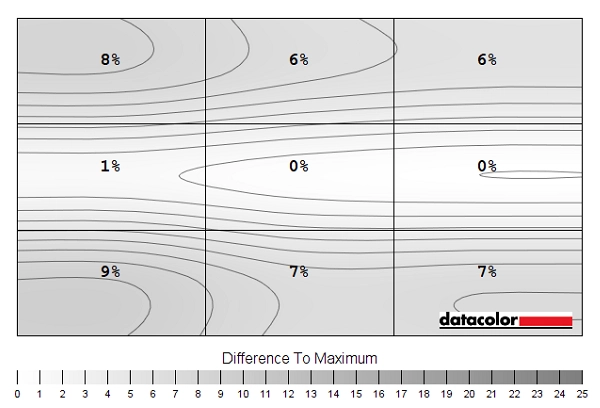
Luminance uniformity map
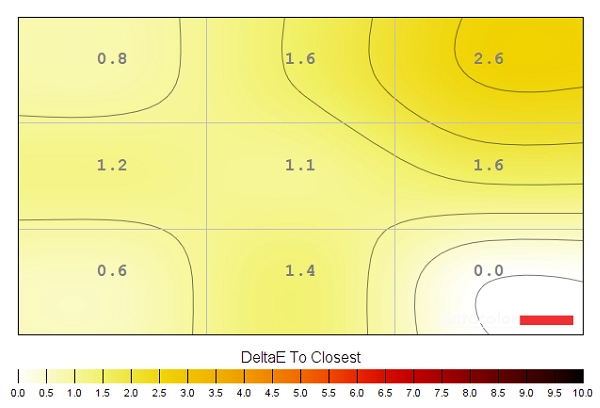
Colour temperature uniformity map
Contrast in games and movies
Lagom contrast tests
Colour reproduction
Colour gamut
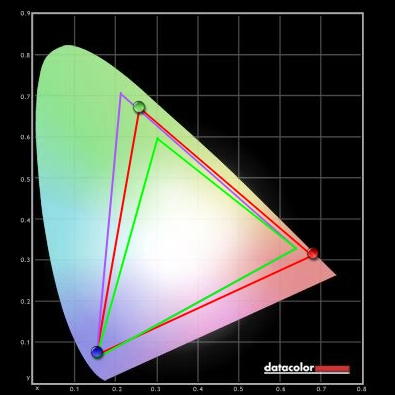
Colour gamut 'Test Settings'
Colour in games and movies
Viewing angles
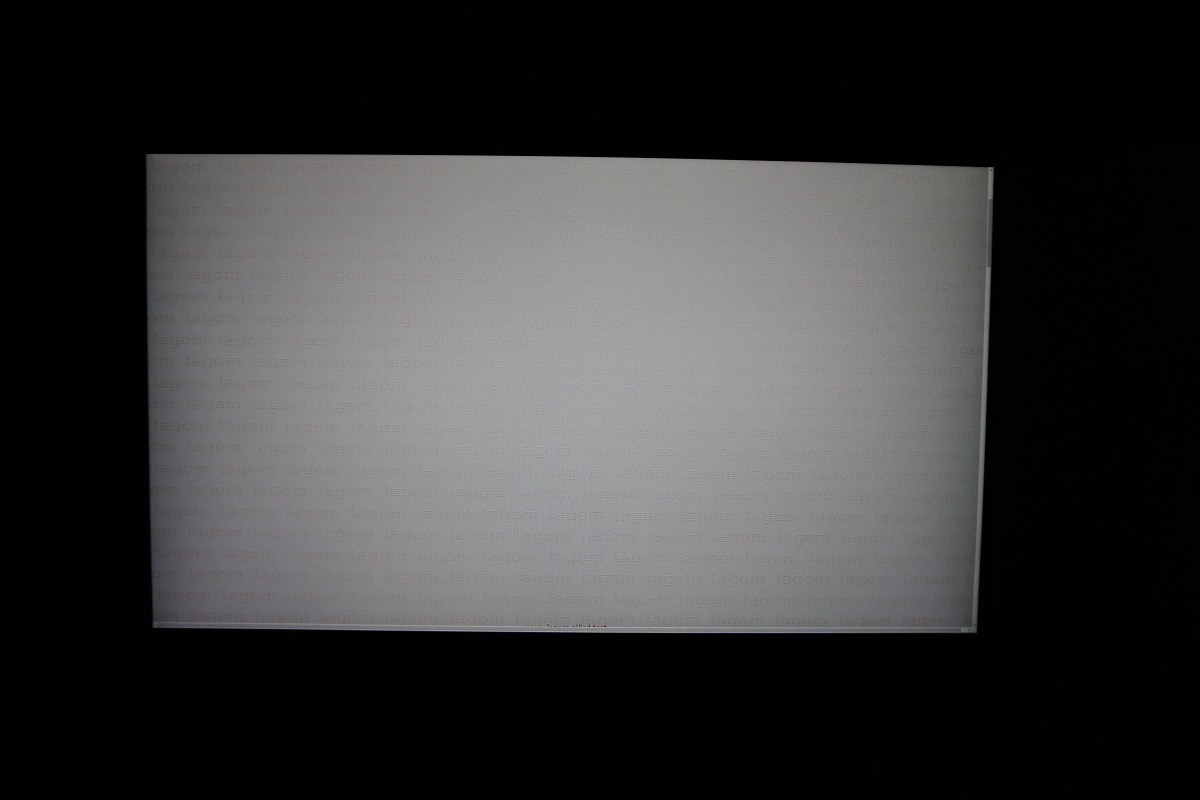
The following video shows how this test appeared from a variety of viewing angles. It also shows a mixed and dark desktop background. For the mixed desktop background, you can see a loss of contrast and saturation as viewing angles become more extreme. For the dark background you can see a purple and silver ‘VA glow’ which blooms out from more extreme angles, as noted earlier.
Interlace pattern artifacts
Responsiveness
Input lag
Perceived blur (pursuit photography)
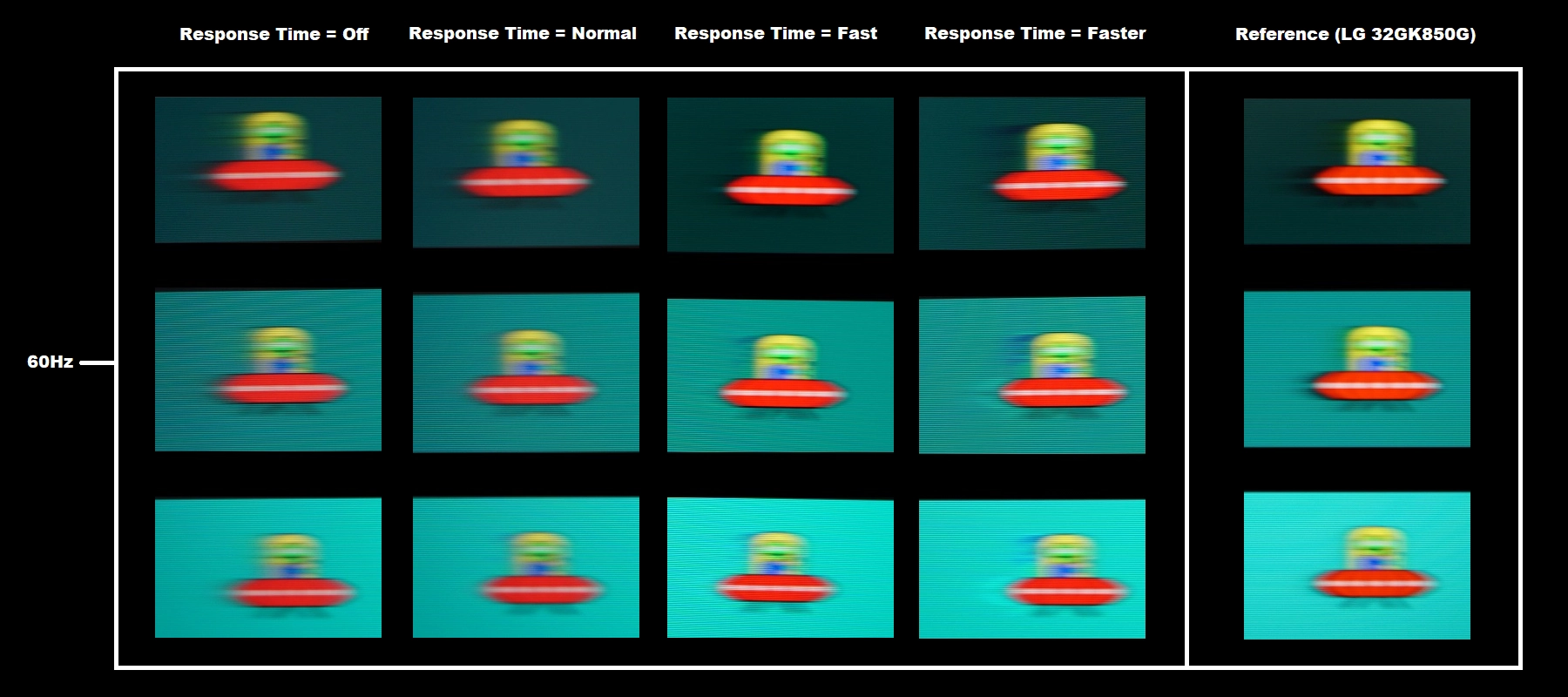
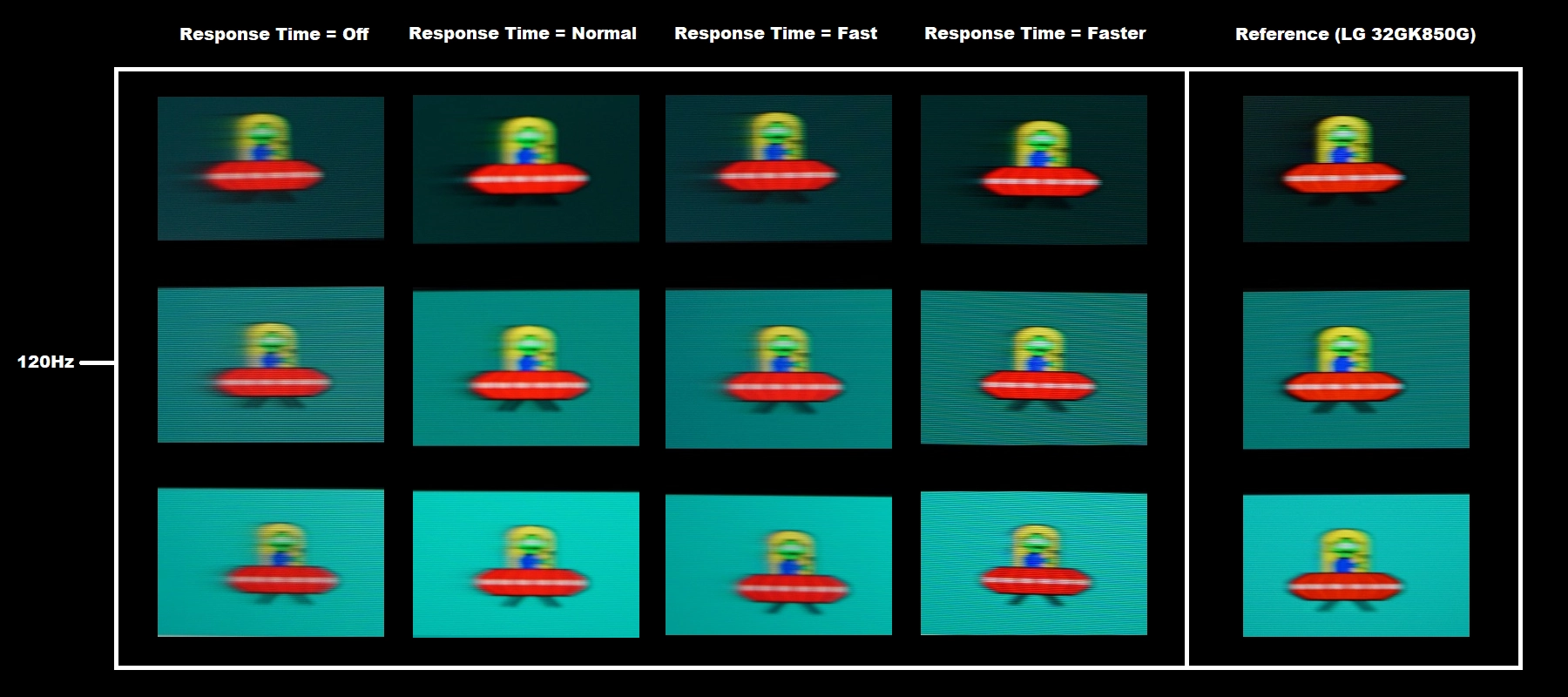
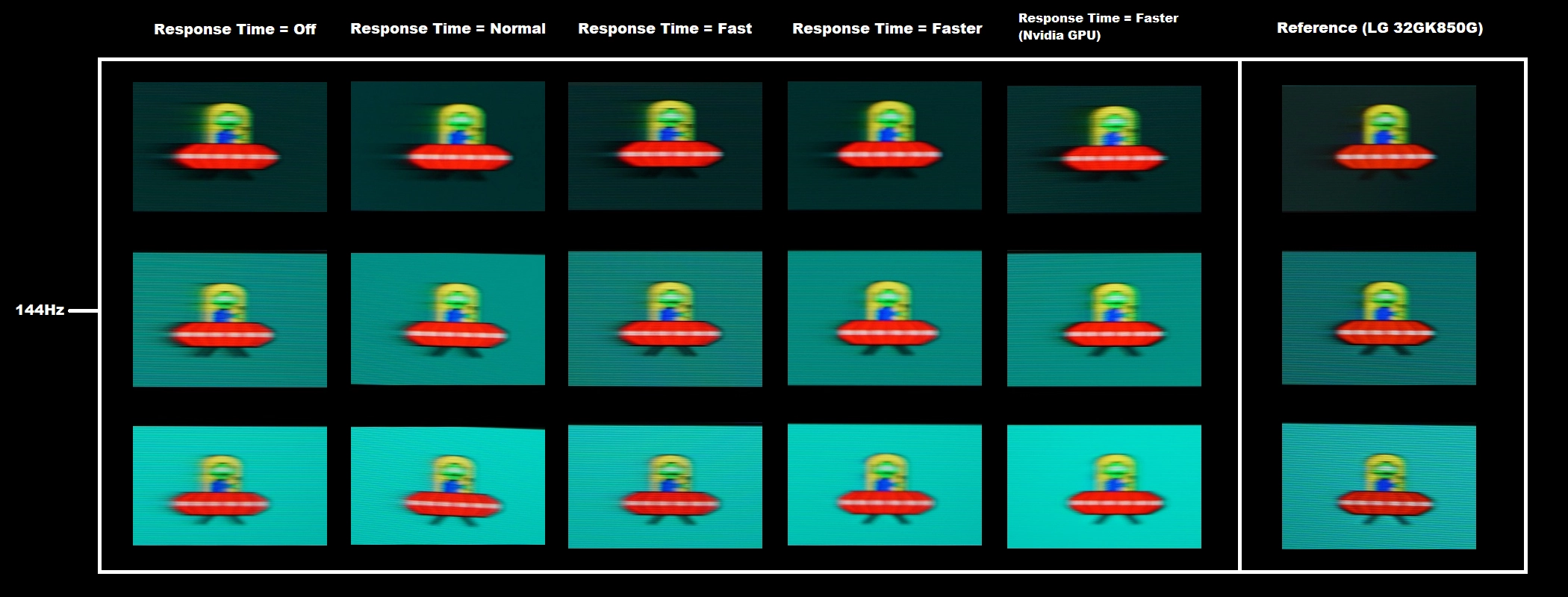
Responsiveness in games and movies
FreeSync – the technology and activating it
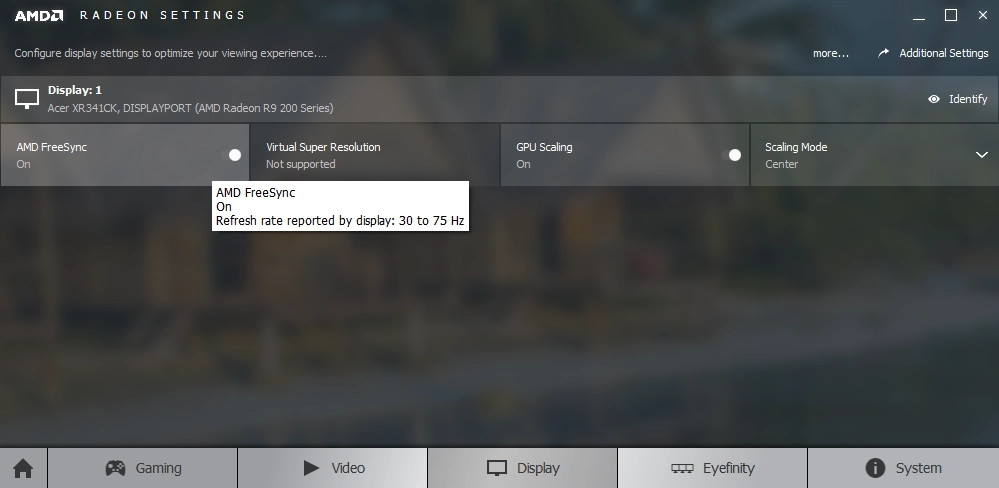
The LG supports a variable refresh rate range of 72 – 144Hz. The range here is more limited than the advertised 48 – 144Hz using the ‘Extended’ mode in the OSD, but this could be just an issue with our early revision. We tried the latest available monitor driver, too, but this didn’t make a difference. That means that if the game is running between 72fps and 144fps, the monitor will adjust its refresh rate to match. When the frame rate rises above 144fps, the monitor will stay at 144Hz and the GPU will respect your selection of ‘VSync on’ or ‘VSync off’ in the graphics driver. With ‘VSync on’ the frame rate will not be allowed to rise above 144fps, at which point VSync activates and imposes the usual associated latency penalty. With ‘VSync off’ the frame rate is free to climb as high as the GPU will output (potentially >144fps). AMD LFC (Low Framerate Compensation) is also supported by this model, which means that the refresh rate will stick to multiples of the frame rate where it falls below the 72Hz (72fps) floor of operation for FreeSync. If a game ran at 32fps, for example, the refresh rate would be 128Hz to help keep tearing and stuttering at bay. This feature is used regardless of VSync setting, so it’s only above the ceiling of operation where the VSync setting makes a difference.
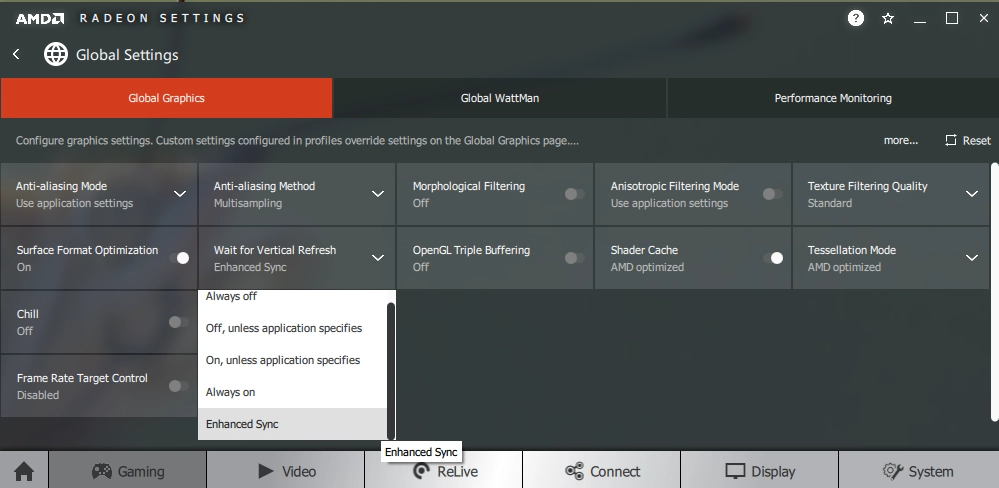
Note that if you enter the OSD the frame rate displayed at the top will update in near enough real-time to reflect changes in the frame rate if FreeSync is active and things are within the FreeSync window of operation. Also note that FreeSync only removes stuttering or juddering related to mismatches between frame rate and refresh rate. It can’t compensate for other interruptions to smooth game play, for example network latency or insufficient system memory.
FreeSync – the experience
Motion Blur Reduction
HDR (High Dynamic Range)
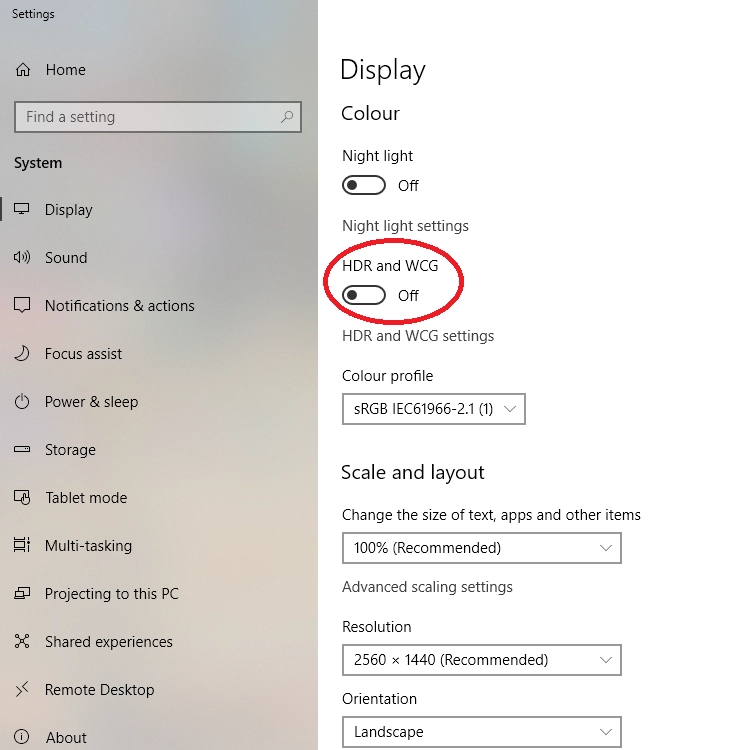

Colour gamut 'Test Settings'
The 31.5″ 2560 x 1440 experience
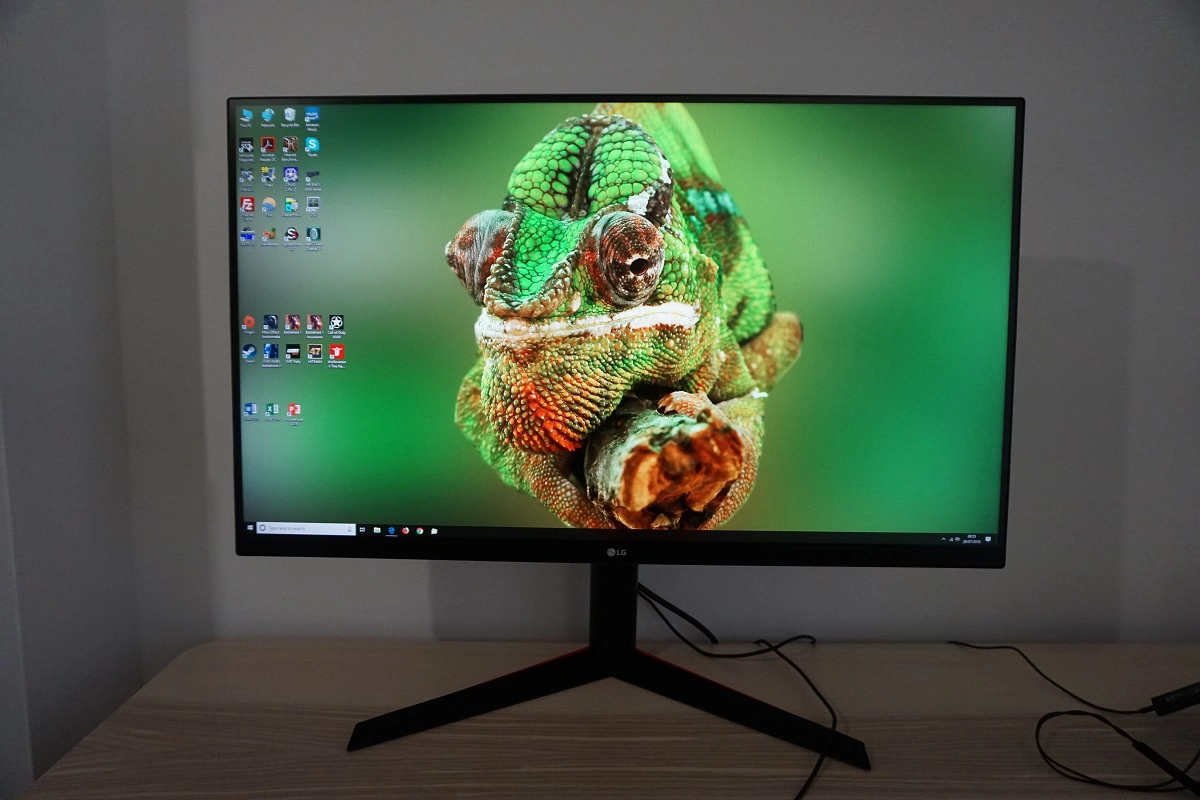
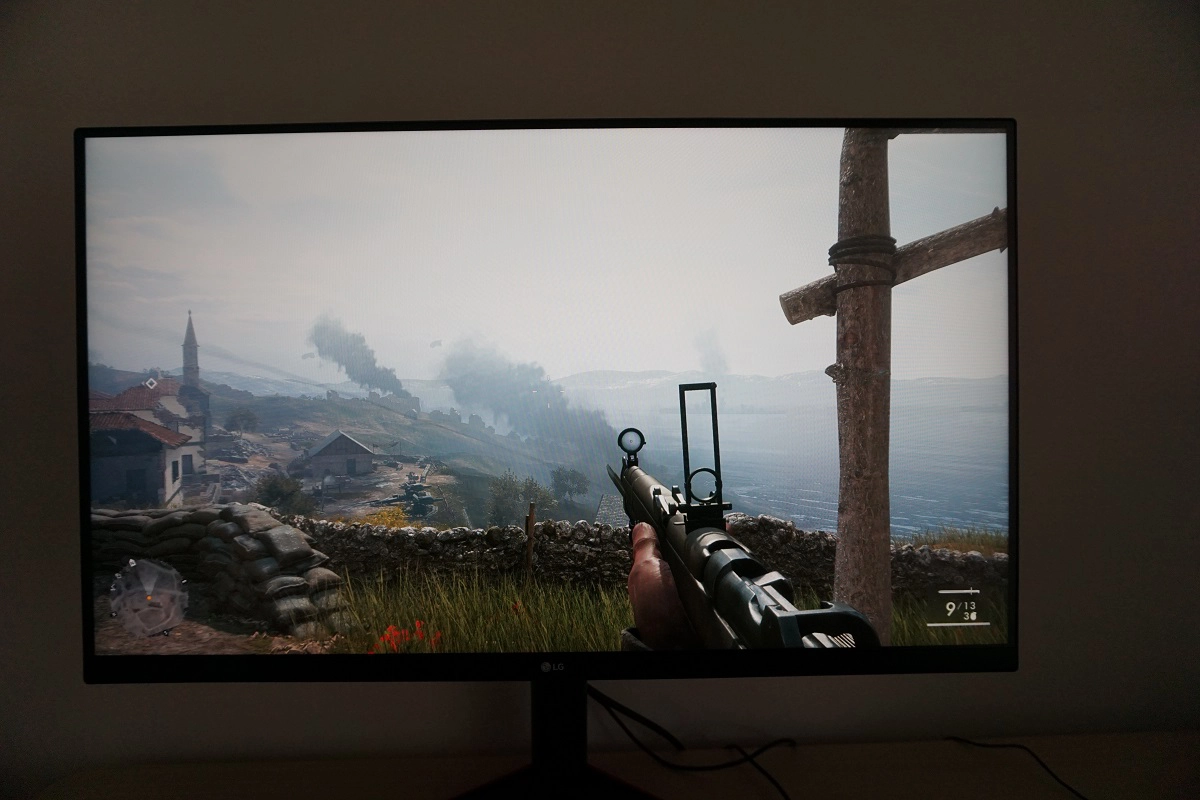
Interpolation and upscaling
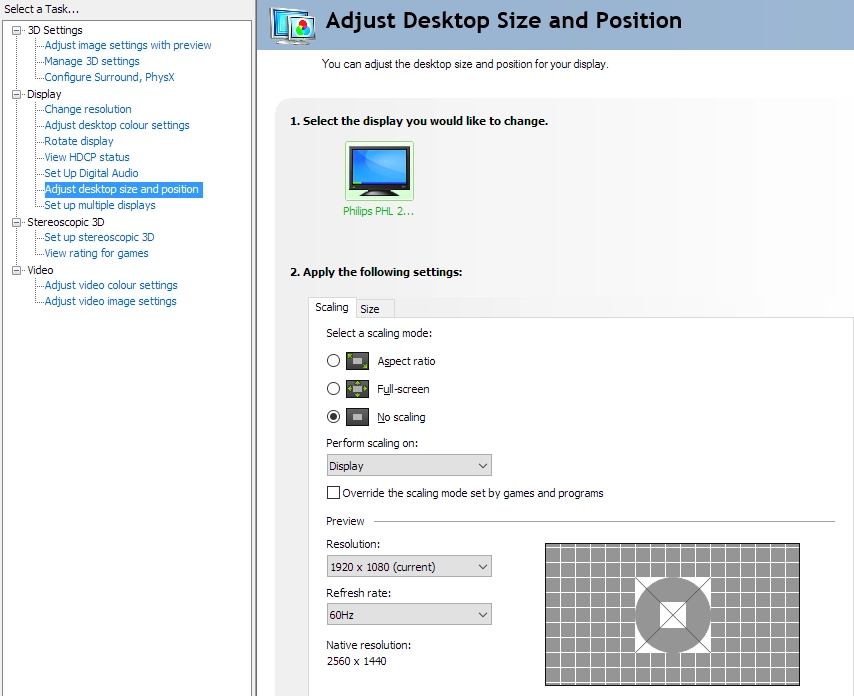
Video review
Timestamps:
Features & Aesthetics
Contrast
Colour reproduction
HDR (High Dynamic Range)
Responsiveness
Conclusion
Positives Negatives A vibrant and varied image following minor OSD tweaking, with good ‘2.2’ gamma tracking and a generous colour gamut far exceeding sRGB
Weaknesses in colour consistency compared to IPS-type panels
Strong static contrast, minimal ‘black crush’, low ‘VA glow’ and a light matte screen surface to keep the image free from obvious graininess Static contrast not as strong as some VA models – an even lighter matte screen surface might have been nice, too Low input lag, a decent 144Hz performance and support for FreeSync 2
Some weaknesses with pixel responsiveness (especially compared to the G-SYNC model), high FreeSync floor and an HDR performance that’s best to forget about
A decent pixel density and resolution plus a solid and ergonomically flexible design
The ‘Sphere Lighting’ of the G-SYNC model was lacking and we quite liked that feature 🙁
As an Amazon Associate I earn from qualifying purchases made using the below link. Where possible, you’ll be redirected to your nearest store. Further information on supporting our work.


